Samsung Electronics Co LCOTR14N Microwave Oven User Manual
Samsung Electronics Co Ltd Microwave Oven Users Manual
Users Manual
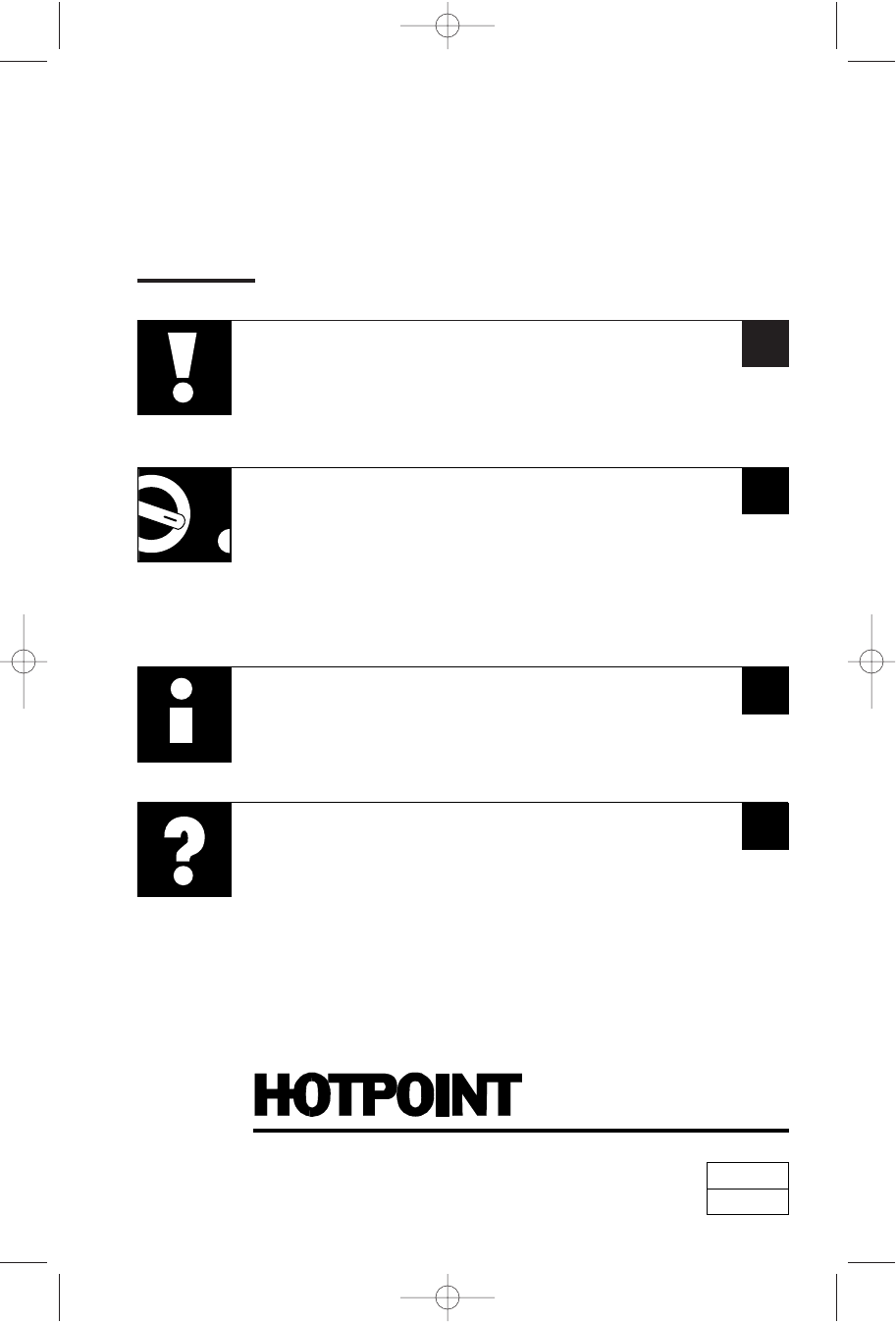
Counter Saver Plus Microwave Oven
Owner’s Manual
2
30
Helpful Information
Microwave Terms 30
Care and Cleaning 31
36
If Something Goes Wrong
Before You Call For Service 36
Hotpoint Service Numbers 38
Warranty Back Cover
11
Important Safety Information
Precautions to Avoid Possible Exposure
to Excessive Microwave Energy 2
Special Notes About Microwaving 6
Operating Instructions
Features of Your Microwave 11
The Controls on Your Microwave 12
Time Features 15
Convenience Features 21
Other Features 25
Hotpoint.com
RVM1435, 950 Watts
RVM1635, 1000 Watts
39-40427
06-04 JR
39-40427v06 6/1/04 4:15 PM Page 1
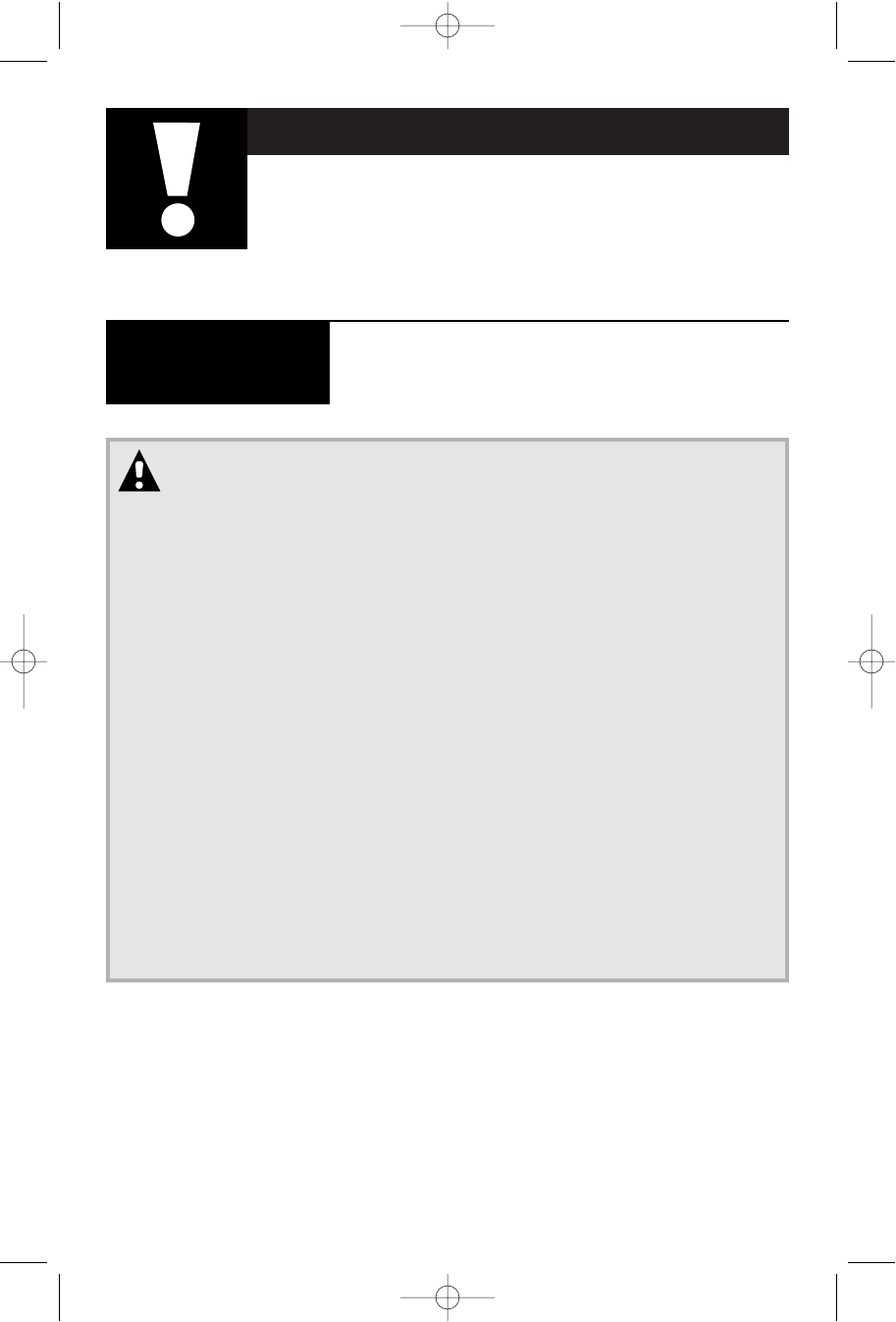
2
IMPORTANT SAFETY INFORMATION
READ ALL SAFETY
INFORMATION BEFORE USING
FOR YOUR
SAFETY
PRECAUTIONS
TO AVOID
POSSIBLE
EXPOSURE
TO EXCESSIVE
MICROWAVE
ENERGY
For your safety, the information in this manual
must be followed to minimize the risk of fire
or explosion or to prevent property damage,
personal injury or loss of life.
Do Not Attempt
to operate this oven
with the door open
since open-door
operation can result
in harmful exposure
to microwave energy.
It is important not to
defeat or tamper with
the safety interlocks.
Do Not Place any object
between the oven front
face and the door or
allow soil or cleaner
residue to accumulate
on sealing surfaces.
Do Not Operate the oven
if it is damaged. It is
particularly important
that the oven door
close properly and
that there is no
damage to the:
1door (bent),
2hinges and latches
(broken or loosened),
3door seals and sealing
surfaces.
The Oven Should Not
be adjusted or repaired
by anyone except
properly qualified
service personnel.
39-40427v06 6/1/04 4:15 PM Page 2
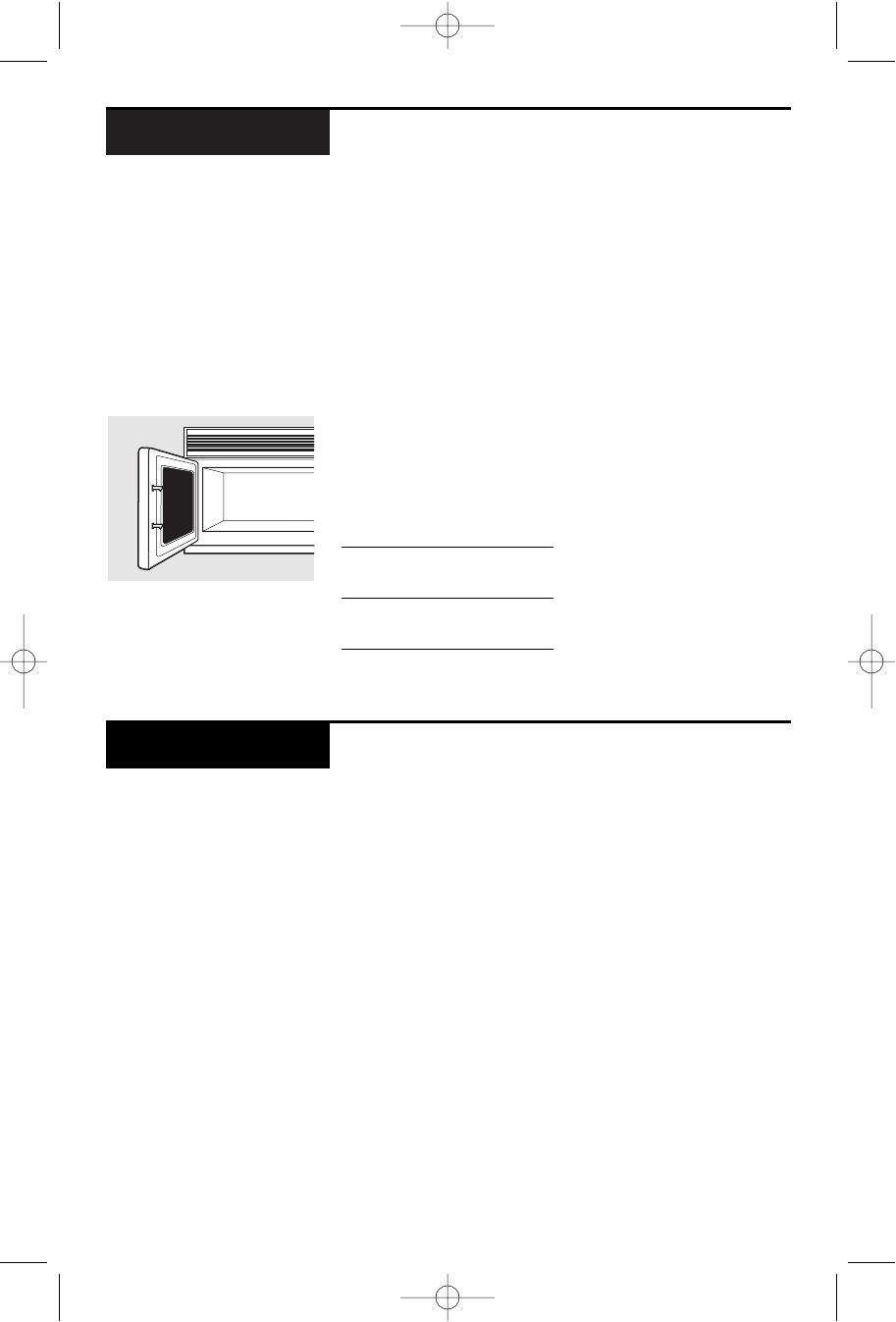
3
Welcome to the GE family.
We’re proud of our quality
products and we believe
in dependable service.
You’ll see it in this
easy-to-use manual and
you’ll hear it in the friendly
voices of our consumer
service department.
Best of all, you’ll experience
these values each time you
use your microwave. That’s
important, because your new
microwave will be part of
your family for a long time.
Welcome
Write down the model
and serial numbers here.
They are on a label inside
the oven.
Model number
Serial number
Date of purchase
Staple your receipt to the
inside back cover of this
manual. You will need it
to obtain service under
warranty.
Before you call for service,
there are a few things you
can do to help us serve you
better.
Read this manual.
It contains instructions to
help you use and maintain
your microwave properly.
If you received a damaged
oven…immediately contact
the dealer (or builder)
that sold you the oven.
Save time and money.
Check the section titled
“If Something Goes
Wrong” before calling.
This section helps you
solve common problems
that might occur.
If you do need service,
you can relax knowing
help is only a phone call
away. A list of toll-free
customer service numbers
is included in the back of
this manual.
Need Help?
Start Here!…Before using your Microwave
39-40427v06 6/1/04 4:15 PM Page 3
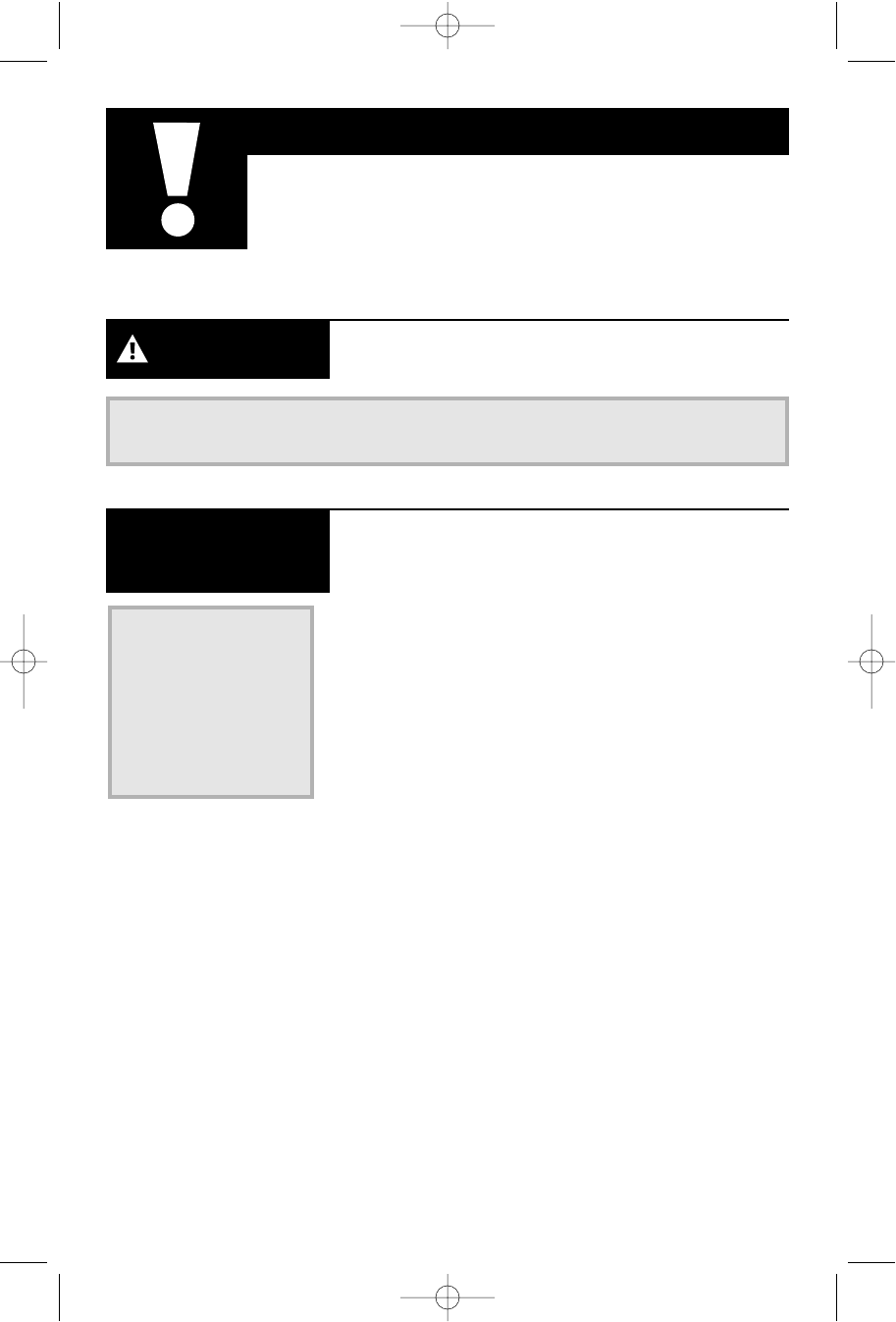
When using electrical appliances, basic safety precautions should be followed, including
the following:
WARNING
•Read and follow the
specific “Precautions to
Avoid Possible Exposure
to Excessive Microwave
Energy” on page 2.
•This appliance must be
grounded. Connect only
to properly grounded
outlet. See Grounding
Instructions section on
page 10.
•Do not mount this
appliance over a sink.
•Install or locate this
appliance only in
accordance with the
provided Installation
Instructions.
•This over-the-range oven
was designed for use over
ranges no wider than 36.″
It may be installed over
both gas and electric
cooking equipment.
•Do not operate this
appliance if it has a
damaged power cord or
plug, if it is not working
properly or if it has been
damaged or dropped.
If the power cord is
damaged, it must be
replaced by General
Electric Service or an
authorized service agent
using a power cord from
General Electric.
•Do not cover or block
any openings on the
appliance.
•Use this appliance only
for its intended use as
described in this manual.
Do not use corrosive
chemicals or vapors in
this appliance. This
microwave oven is
specifically designed to
heat, dry or cook food,
and is not intended
for laboratory or
industrial use.
This microwave oven is
UL listed for installation
over electric and gas
ranges.
This microwave oven is
not approved or tested
for marine use.
SAFETY
PRECAUTIONS
4
IMPORTANT SAFETY INFORMATION
READ ALL SAFETY
INFORMATION BEFORE USING
39-40427v06 6/1/04 4:15 PM Page 4

•Do not store this appliance
outdoors.
•Do not use this product
near water—for example,
in a wet basement,
near a swimming pool,
near a sink or in similar
locations.
•Keep power cord away
from heated surfaces.
•Do not immerse power
cord or plug in water.
•To reduce the risk of fire
in the oven cavity:
— Do not overcook food.
Carefully attend appliance
when paper, plastic or
other combustible
materials are placed
inside the oven while
cooking.
— Remove wire twist-ties
and metal handles
from paper or plastic
containers before placing
them in the oven.
— Do not use the oven
for storage purposes.
Do not leave paper
products, cooking
utensils or food in the
oven when not in use.
— If materials inside oven
ignite, keep the oven
door closed, turn the
oven off and disconnect
the power cord, or shut
off power at the fuse or
circuit breaker panel.
If the door is opened,
the fire may spread.
•See door surface cleaning
instructions in the Care
and Cleaning section(s)
of this manual.
•This appliance must only
be serviced by qualified
service personnel. Contact
nearest authorized service
facility for examination,
repair or adjustment.
•As with any appliance,
close supervision is
necessary when used
by children.
•Do not store anything
directly on top of the
microwave oven surface
when the microwave oven
is in operation.
SAVE THESE INSTRUCTIONS
5
39-40427v06 6/1/04 4:15 PM Page 5

IMPORTANT SAFETY INFORMATION
SPECIAL NOTES ABOUT MICROWAVING
Arcing is the microwave
term for sparks in the
oven. Arcing is caused by:
•Metal or foil touching
the side of the oven.
•Foil not molded to food
(upturned edges act like
antennas).
•Metal, such as twist-ties,
poultry pins or gold-
rimmed dishes, in the
microwave.
•Recycled paper towels
containing small metal
pieces being used in
the microwave.
If you see arcing, press
the CLEAR/OFF pad and
correct the problem.
ARCING
•Do not pop popcorn in
your microwave oven
unless in a special
microwave popcorn
accessory or unless you
use popcorn labeled for
use in microwave ovens.
•Some products such as
whole eggs and sealed
containers—for example,
closed jars—are able to
explode and should not
be heated in this
microwave oven. Such use
of the microwave oven
could result in injury.
•Do not boil eggs in a
microwave oven. Pressure
will build up inside egg
yolk and will cause it to
burst, possibly resulting
in injury.
•Operating the microwave
with no food inside for
more than a minute or
two may cause damage
to the oven and could
start a fire. It increases
the heat around the
magnetron and can
shorten the life of
the oven.
•Foods with unbroken
outer “skin” such as
potatoes, hot dogs,
sausages, tomatoes,
apples, chicken livers
and other giblets, and
egg yolks should be
pierced to allow steam
to escape during
cooking.
FOODS
6
39-40427v06 6/1/04 4:15 PM Page 6

7
SAFETY FACT
SUPERHEATED WATER
Liquids, such as water,
coffee or tea, are able to
be overheated beyond
the boiling point without
appearing to be boiling.
Visible bubbling or boiling
when the container is
removed from the microwave
oven is not always present.
THIS COULD RESULT
IN VERY HOT LIQUIDS
SUDDENLY BOILING OVER
WHEN THE CONTAINER IS
DISTURBED OR A SPOON
OR OTHER UTENSIL IS
INSERTED INTO THE LIQUID.
To reduce the risk of injury
to persons:
— Do not overheat the
liquid.
— Stir the liquid both
before and halfway
through heating it.
— Do not use straight-sided
containers with narrow
necks.
— After heating, allow
the container to stand
in the microwave oven
for a short time before
removing the container.
— Use extreme care when
inserting a spoon or
other utensil into the
container.
•Avoid heating baby food
in glass jars, even with the
lid off. Make sure all
infant food is thoroughly
cooked. Stir food to
distribute the heat evenly.
Be careful to prevent
scalding when warming
formula or breast milk.
The container may feel
cooler than the milk really
is. Always test the milk
before feeding the baby.
•Don’t defrost frozen
beverages in narrow-
necked bottles (especially
carbonated beverages).
Even if the container is
opened, pressure can
build up. This can cause
the container to burst,
possibly resulting in
injury.
•Hot foods and steam
can cause burns. Be
careful when opening
any containers of hot
food, including popcorn
bags, cooking pouches
and boxes. To prevent
possible injury, direct
steam away from hands
and face.
•Do not overcook
potatoes. They could
dehydrate and catch
fire, causing damage
to your oven.
•Cook meat and poultry
thoroughly—meat to
at least an INTERNAL
temperature of 160°F
and poultry to at least an
INTERNAL temperature
of 180°F. Cooking to
these temperatures
usually protects against
foodborne illness.
39-40427v06 6/1/04 4:15 PM Page 7
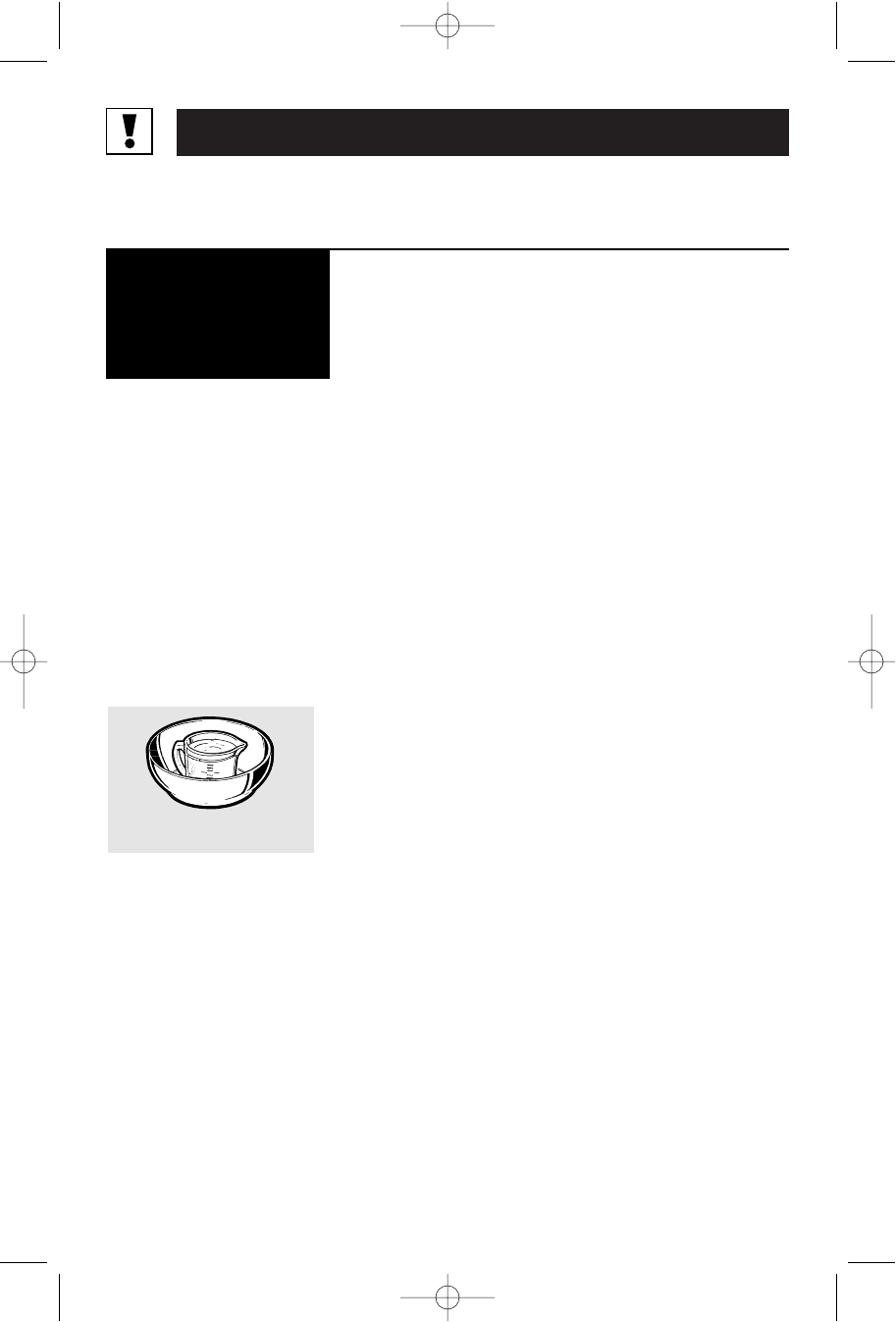
IMPORTANT SAFETY INFORMATION
SPECIAL NOTES ABOUT MICROWAVING
Make sure all cookware
used in your microwave
oven is suitable for
microwaving. Most glass
casseroles, cooking dishes,
measuring cups, custard
cups, pottery or china
dinnerware which does not
have metallic trim or glaze
with a metallic sheen can
be used. Some cookware
is labeled “suitable for
microwaving.”
•If you are not sure if
a dish is microwave-safe,
use this test: Place in the
oven both the dish you
are testing and a glass
measuring cup filled with
1 cup of water—set the
measuring cup either
in or next to the dish.
Microwave 30–45 seconds
at high. If the dish heats,
it should not be used for
microwaving.
If the dish remains cool
and only the water in the
cup heats, then the dish
is microwave-safe.
•If you use a meat ther-
mometer while cooking,
make sure it is safe for
use in microwave ovens.
•Do not use recycled
paper products. Recycled
paper towels, napkins
and waxed paper can
contain metal flecks
which may cause arcing
or ignite. Paper products
containing nylon or
nylon filaments should
be avoided, as they may
also ignite.
•Some styrofoam trays
(like those that meat is
packaged on) have a thin
strip of metal embedded
in the bottom. When
microwaved, the metal can
burn the floor of the oven
or ignite a paper towel.
•Do not use the microwave
to dry newspapers.
•Not all plastic wrap is
suitable for use in
microwave ovens.
Check the package
for proper use.
•Paper towels, waxed
paper and plastic wrap
can be used to cover
dishes in order to retain
moisture and prevent
spattering. Be sure to
vent plastic wrap so steam
can escape.
•Cookware may become
hot because of heat
transferred from the
heated food. Pot holders
may be needed to handle
the cookware.
•“Boilable” cooking
pouches and tightly
closed plastic bags should
be slit, pierced or vented
as directed by package.
If they are not, plastic
could burst during or
immediately after
cooking, possibly resulting
in injury. Also, plastic
storage containers should
be at least partially
uncovered because they
form a tight seal. When
cooking with containers
tightly covered with
plastic wrap, remove
covering carefully and
direct steam away from
hands and face.
MICROWAVE-
SAFE
COOKWARE
8
How to test for a microwave-
safe dish.
39-40427v06 6/1/04 4:15 PM Page 8
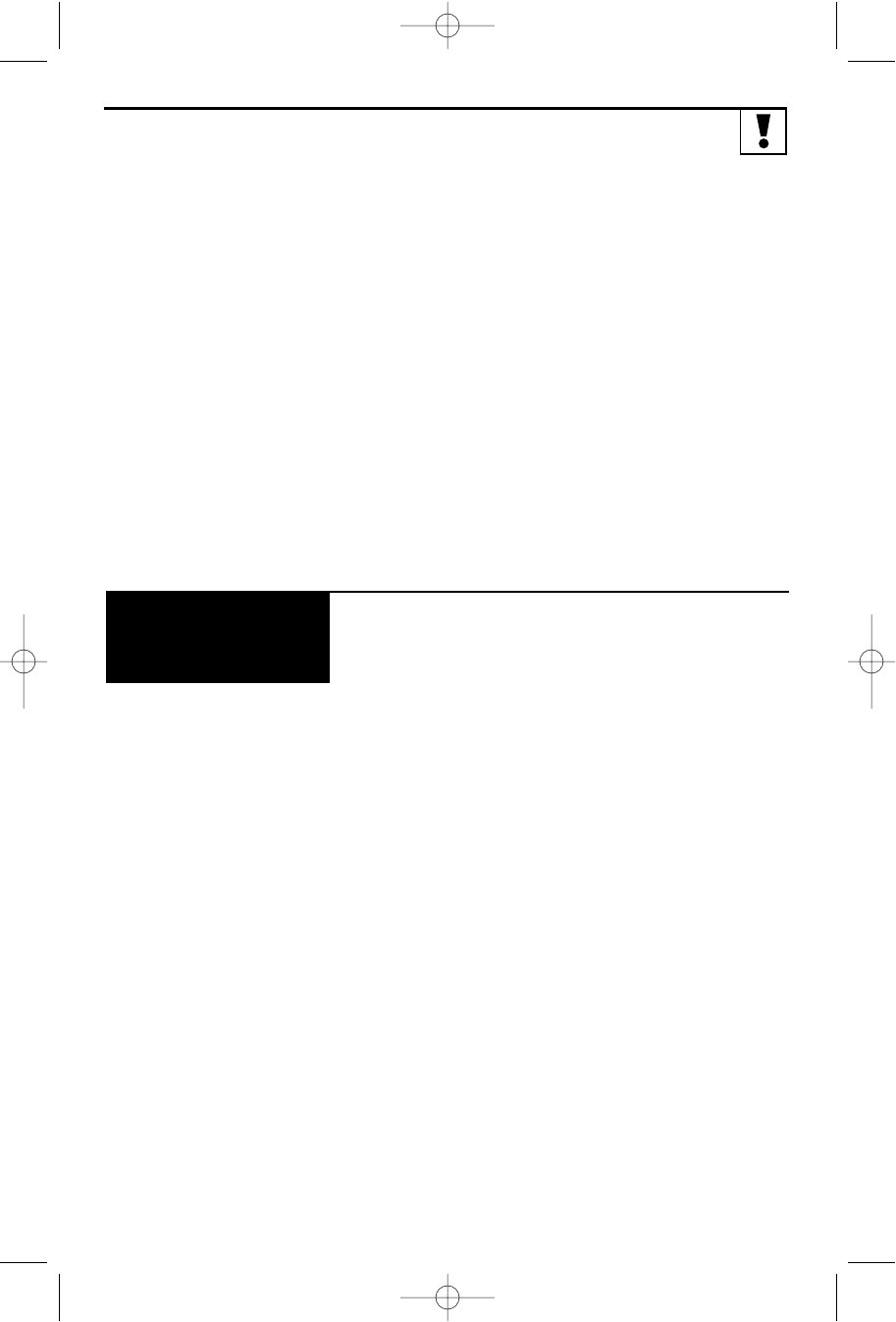
9
•Use foil only as directed in
this manual. TV dinners
may be microwaved in foil
trays less than 3/4″high;
remove the top foil cover
and return the tray to the
box. When using foil in
the microwave oven, keep
the foil at least 1″away
from the sides of the oven.
•Plastic cookware—Plastic
cookware designed for
microwave cooking is very
useful, but should be used
carefully. Even microwave-
safe plastic may not be as
tolerant of overcooking
conditions as are glass or
ceramic materials and
may soften or char if
subjected to short periods
of overcooking. In longer
exposures to overcooking,
the food and cookware
could ignite.
Follow these guidelines:
1Use microwave-safe
plastics only and use
them in strict compliance
with the cookware
manufacturer’s
recommendations.
2Do not microwave empty
containers.
3Do not permit children
to use plastic cookware
without complete
supervision.
The fan will operate
automatically under
certain conditions (see
Automatic Fan feature).
Take care to prevent the
starting and spreading of
accidental cooking fires
while the vent fan is in use.
•Clean the underside of
the microwave often.
Do not allow grease
to build up on the
microwave or the
fan filters.
•In the event of a grease
fire on the surface units
below the microwave
oven, smother a flaming
pan on the surface unit
by covering the pan
completely with a lid, a
cookie sheet or a flat tray.
•Use care when cleaning
the vent fan filters.
Corrosive cleaning
agents, such as lye-based
oven cleaners, may
damage the filters.
•When preparing
flaming foods under the
microwave, turn the vent
fan on.
•Never leave surface units
beneath your microwave
oven unattended at high
heat settings. Boilovers
cause smoking and
greasy spillovers that may
ignite and spread if the
microwave vent fan is
operating. To minimize
automatic fan operation,
use adequate sized
cookware and use high
heat on surface units
only when necessary.
THE VENT
FAN
39-40427v06 6/1/04 4:15 PM Page 9
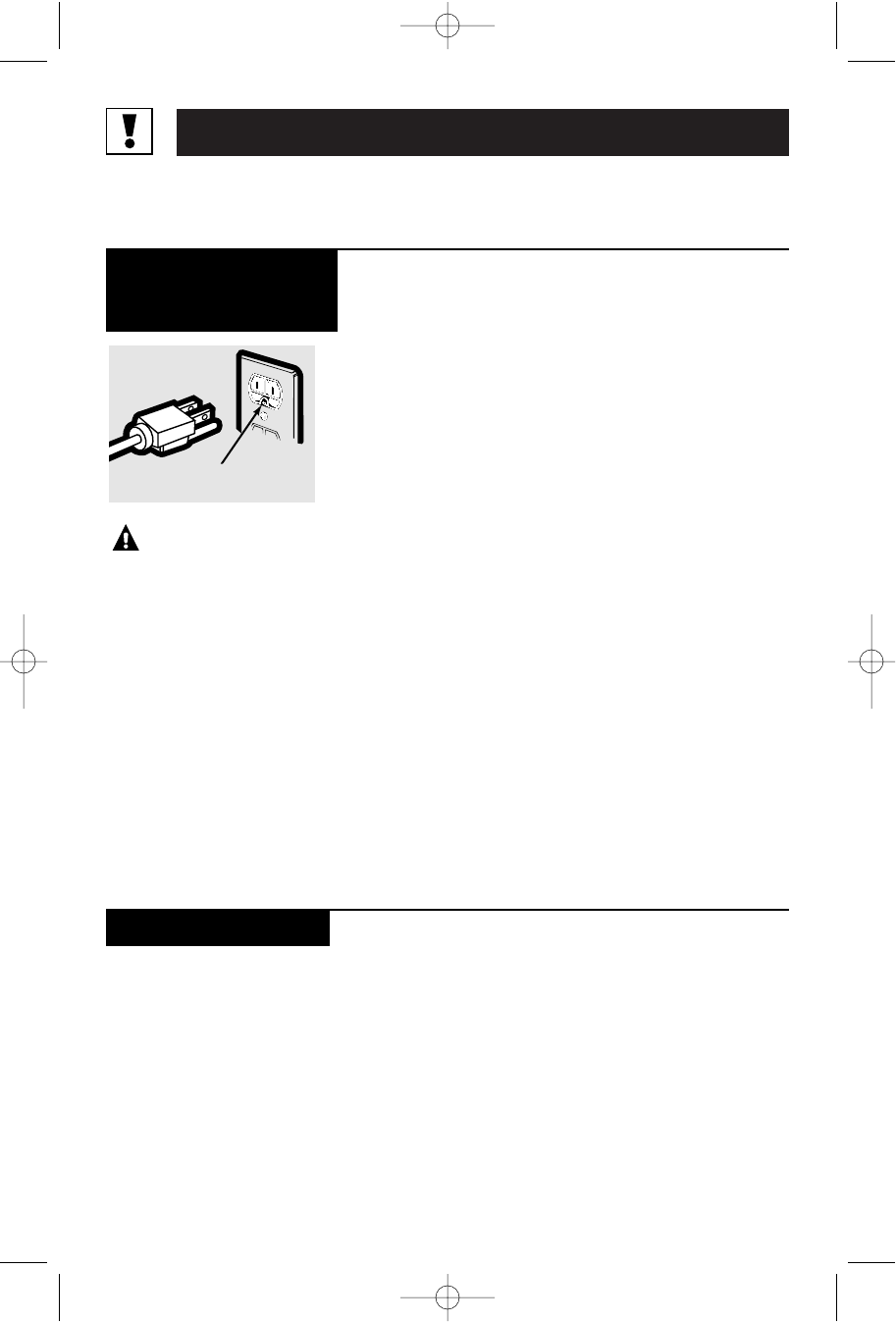
IMPORTANT SAFETY INFORMATION
GROUNDING INSTRUCTIONS/OPTIONAL KITS
WARNING
Improper use of the
grounding plug can result
in a risk of electric shock.
This appliance must be
grounded. In the event of
an electrical short circuit,
grounding reduces the
risk of electric shock by
providing an escape wire
for the electric current.
This appliance is equipped
with a power cord having
a grounding wire with a
grounding plug. The plug
must be plugged into an
outlet that is properly
installed and grounded.
Consult a qualified
electrician or service
technician if the grounding
instructions are not
completely understood,
or if doubt exists as to
whether the appliance is
properly grounded.
If the outlet is a standard
2-prong wall outlet, it is
your personal responsibility
and obligation to have it
replaced with a properly
grounded 3-prong wall
outlet.
Do not, under any
circumstances, cut or
remove the third (ground)
prong from the power cord.
Do not use an adapter plug
with this appliance.
Do not use an extension
cord with this appliance.
If the power cord is too
short, have a qualified
electrician or service
technician install an outlet
near the appliance.
For best operation, plug
this appliance into its own
electrical outlet to prevent
flickering of lights, blowing
of fuse or tripping of circuit
breaker.
GROUNDING
INSTRUCTIONS
Filler Panel Kits
JX40WH or JX46WH—White
JX41 or JX46BL—Black
JX40AL or JX46AL—Almond
When replacing a 36″
range hood, filler panel
kits fill in the additional
width to provide a custom
built-in appearance.
For installation between
cabinets only; not for
end-of-cabinet installation.
Each kit contains two
3″-wide filler panels.
Filter Kits
JX81A—Recirculating
Charcoal Filter Kit
Filter kits are used when
the microwave oven cannot
be vented to the outside.
Available at extra cost from
your Hotpoint supplier.
Optional Kits
Ensure proper ground
exists before use.
10
39-40427v06 6/1/04 4:15 PM Page 10
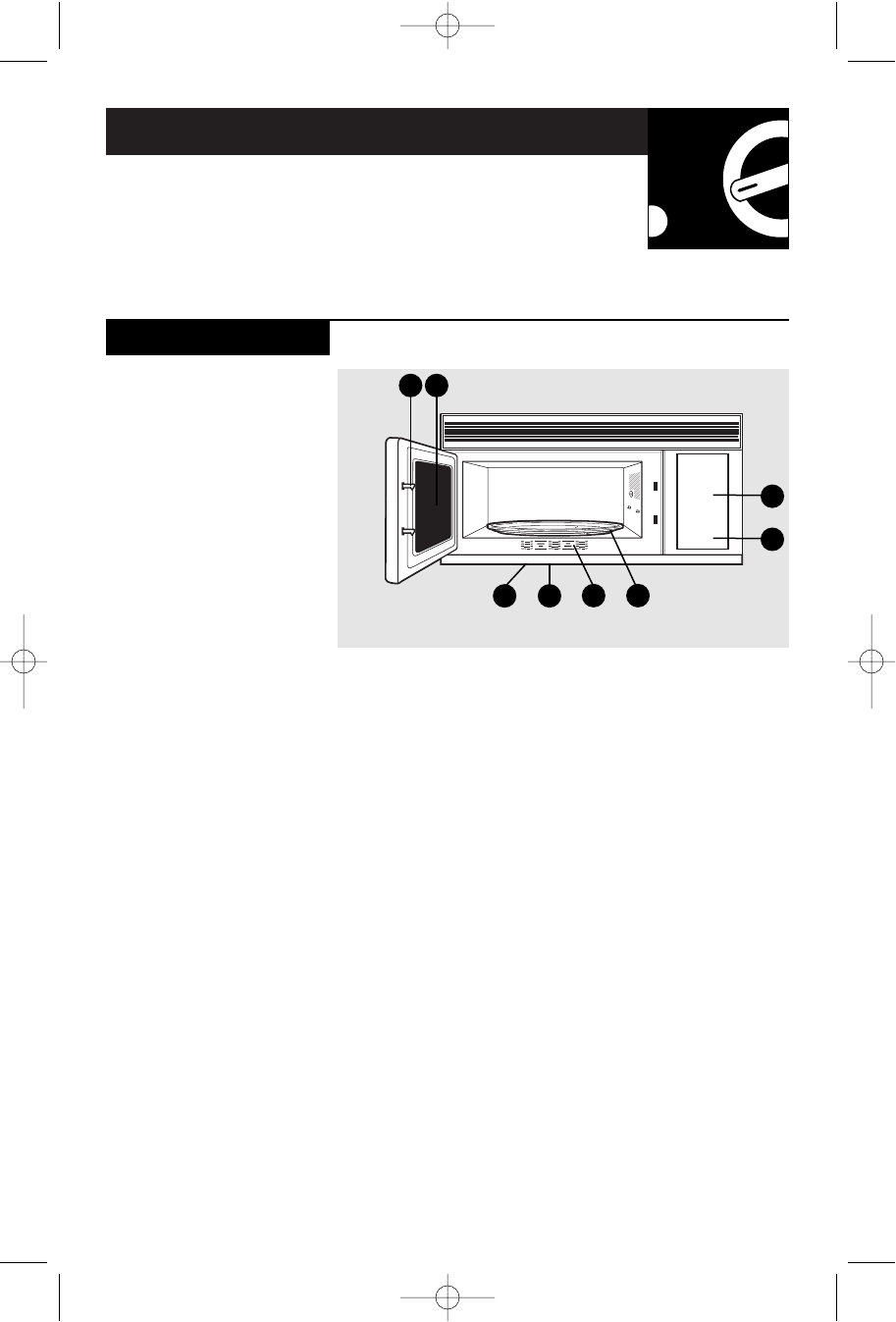
Operating Instructions
Features of Your Microwave
(Throughout this manual, features and appearance
may vary from your model.)
1 Door Latches.
2 Window with Metal
Shield. Screen allows
cooking to be viewed
while keeping
microwaves confined
in the oven.
3 Touch Control Panel.
4 Push to Open. Push to
open the door. The
door must be securely
latched for the
microwave to operate.
5 Cooktop Light.
6 Grease Filter.
7 Removable Turntable.
Turntable and support
must be in place
when using the oven.
The turntable may be
removed for cleaning.
8 Convenience Guide.
NOTE: The rating plate
and oven vent are located
on the inside walls of the
microwave oven.
The interior light is
located on the top of
the cavity.
Features
21
587
11
6
3
4
39-40427v06 6/1/04 4:15 PM Page 11
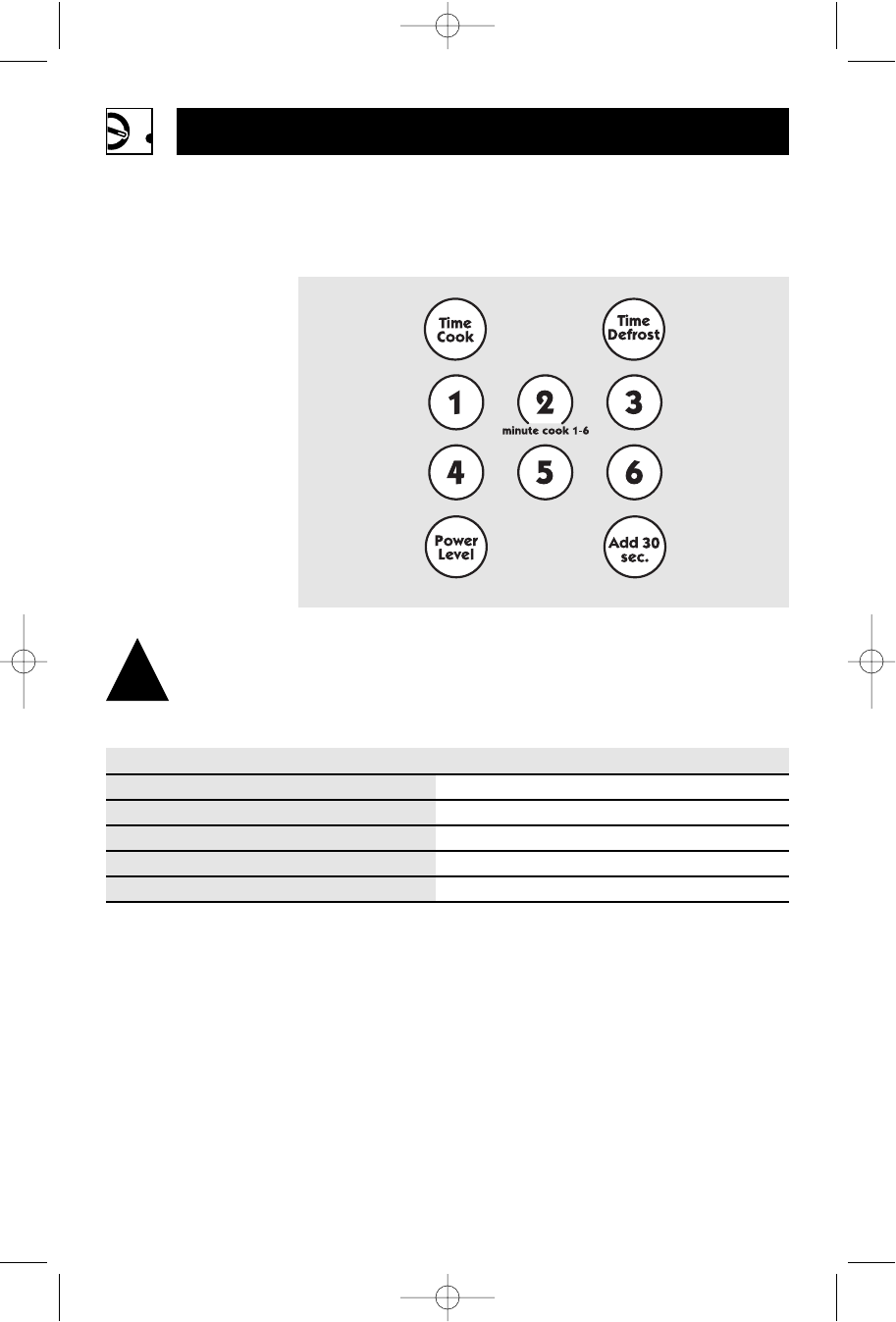
Time Features
Time Cooking
Press Enter
TIME COOK I & II (Press once or twice) Amount of cooking time.
TIME DEFROST Amount of defrosting time.
MINUTE COOK (Press 1–6) Starts immediately!
POWER LEVEL Power level 1–10.
ADD 30 SEC. Starts immediately!
12
Quick Start
The Controls on Your Microwave Oven
(Throughout this manual, features and appearance may vary from your model.)
1
You can microwave
by time, temperature,
or with the
convenience
features.
39-40427v06 6/1/04 4:15 PM Page 12

13
Convenience Features
Press Enter Option
POPCORN Starts immediately! more/less time
serving size
BEVERAGE Starts immediately! serving size
REHEAT Food type 1–7 serving size
AUTO DEFROST Food weight
2
GUIDE ON MICROWAVE
Before you begin, check the guide located
on the inside front of the oven when you
open the door.
GUIDES IN BOOK
•Cooking
•Time Defrost
•Reheat
39-40427v06 6/1/04 4:15 PM Page 13
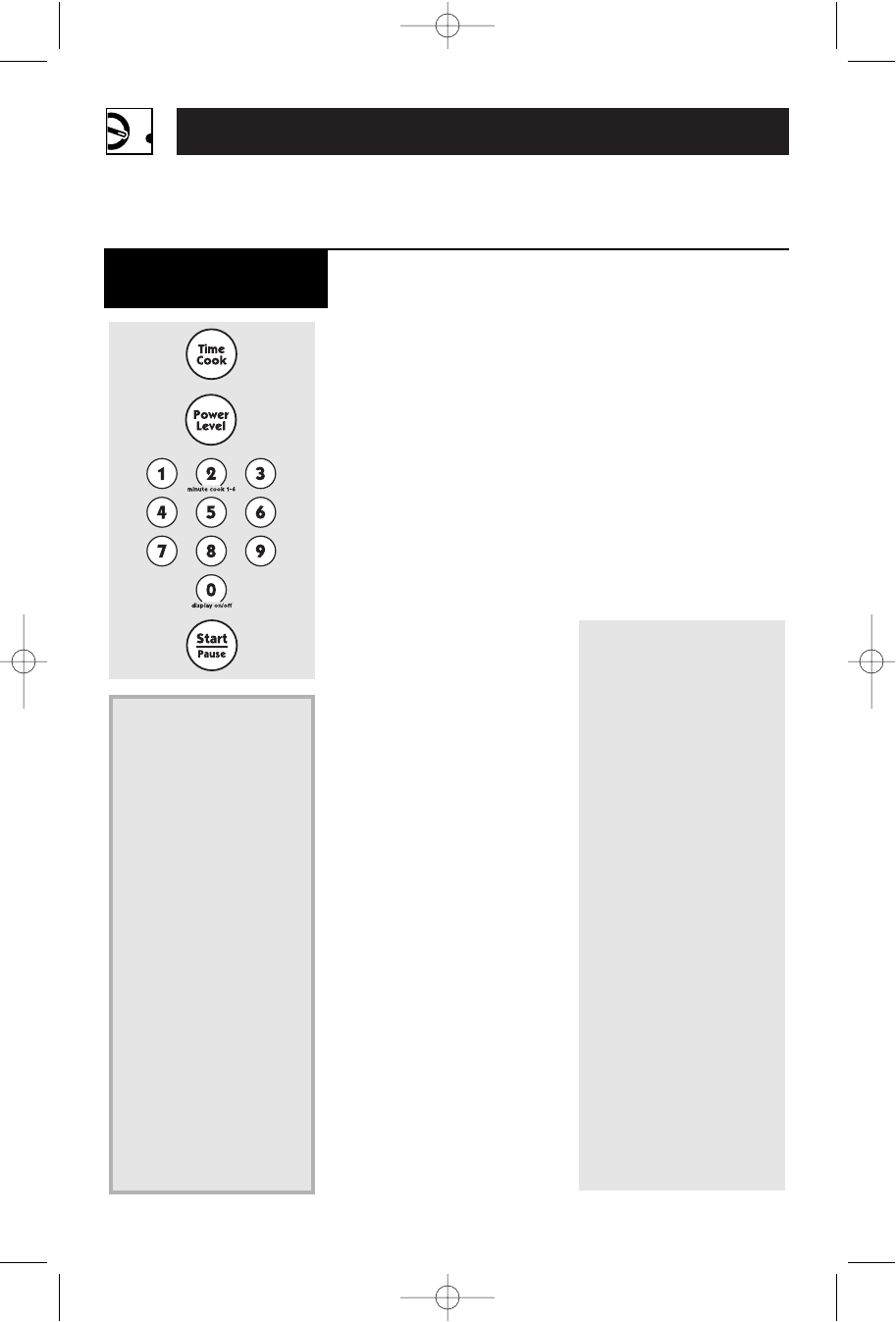
Operating Instructions
Variable power levels add
flexibility to microwave
cooking. The power levels
on the microwave oven
can be compared to the
surface units on a range.
High (power level 10) or
full power is the fastest
way to cook and gives you
100% power. Each power
level gives you microwave
energy a certain percent of
the time. Power level 7 is
microwave energy 70% of
the time. Power level 3 is
energy 30% of the time.
A high setting (10) will
cook faster but food may
need more frequent
stirring, rotating or turning
over. Most cooking will be
done on High (power level
10). A lower setting will
cook more evenly and need
less stirring or rotating of
the food.
Some foods may have
better flavor, texture or
appearance if one of the
lower settings is used. Use
a lower power level when
cooking foods that have a
tendency to boil over, such
as scalloped potatoes.
Rest periods (when the
microwave energy cycles
off) give time for the food
to “equalize” or transfer
heat to the inside of the
food. An example of this is
shown with power level 3—
the defrost cycle. If
microwave energy did not
cycle off, the outside of the
food would cook before
the inside was defrosted.
Here are some examples
of uses for various power
levels:
Power Level Best Uses
High 10 Fish, bacon,
vegetables,
boiling liquids.
Med-High 7 Gentle
cooking of
meat and
poultry;
baking
casseroles
and reheating.
Medium 5 Slow cooking
and tenderizing
such as stews
and less tender
cuts of meat.
Low 2 or 3 Defrosting
without
cooking;
simmering;
delicate sauces.
Warm 1 Keeping food
warm without
overcooking;
softening
butter.
How to Change the
Power Level
The power level may be
entered or changed
immediately after
entering the feature
time for TIME COOK,
TIME DEFROST or
MINUTE COOK. The
power level may also be
changed during time
countdown.
1 Press TIME COOK or
select Time Defrost.
2 Enter cooking or
defrosting time.
3 Press POWER LEVEL.
4 Select desired power
level 1–10.
5 Press START.
Changing Power
Levels
14
39-40427v06 6/1/04 4:15 PM Page 14
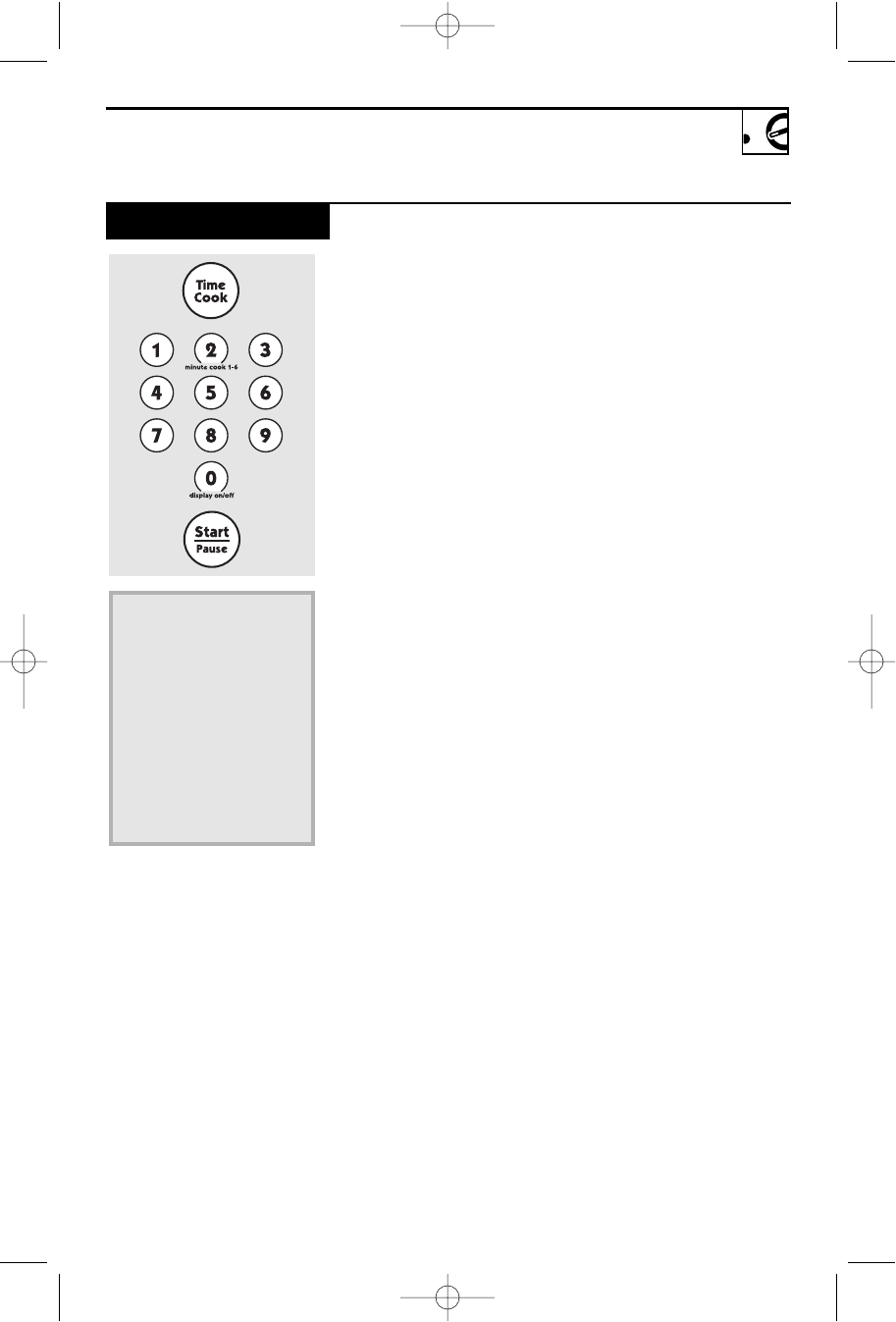
15
Time Features
Time Cook I
Allows you to microwave
for any time up to 99
minutes and 99 seconds.
Power level 10 (High) is
automatically set, but you
may change it for more
flexibility.
You may open the door
during Time Cook to
check the food. Close the
door and press START to
resume cooking.
Time Cook II
Lets you change power
levels automatically during
cooking. Here’s how to
do it:
1Press TIME COOK.
2Enter the first cook time.
3Change the power level
if you don’t want full
power. (Press POWER
LEVEL. Select a desired
power level 1–10.)
4Press TIME COOK
again.
5Enter the second cook
time.
6Change the power level
if you don’t want full
power. (Press POWER
LEVEL. Select a power
level 1–10.)
7Press START.
At the end of Time Cook I,
Time Cook II counts down.
1 Press TIME COOK.
2 Enter cooking time.
3 Change power level
if you don’t want full
power. (Press POWER
LEVEL. Select a
desired power level
1–10.)
4 Press START.
Time Cook
39-40427v06 6/1/04 4:15 PM Page 15
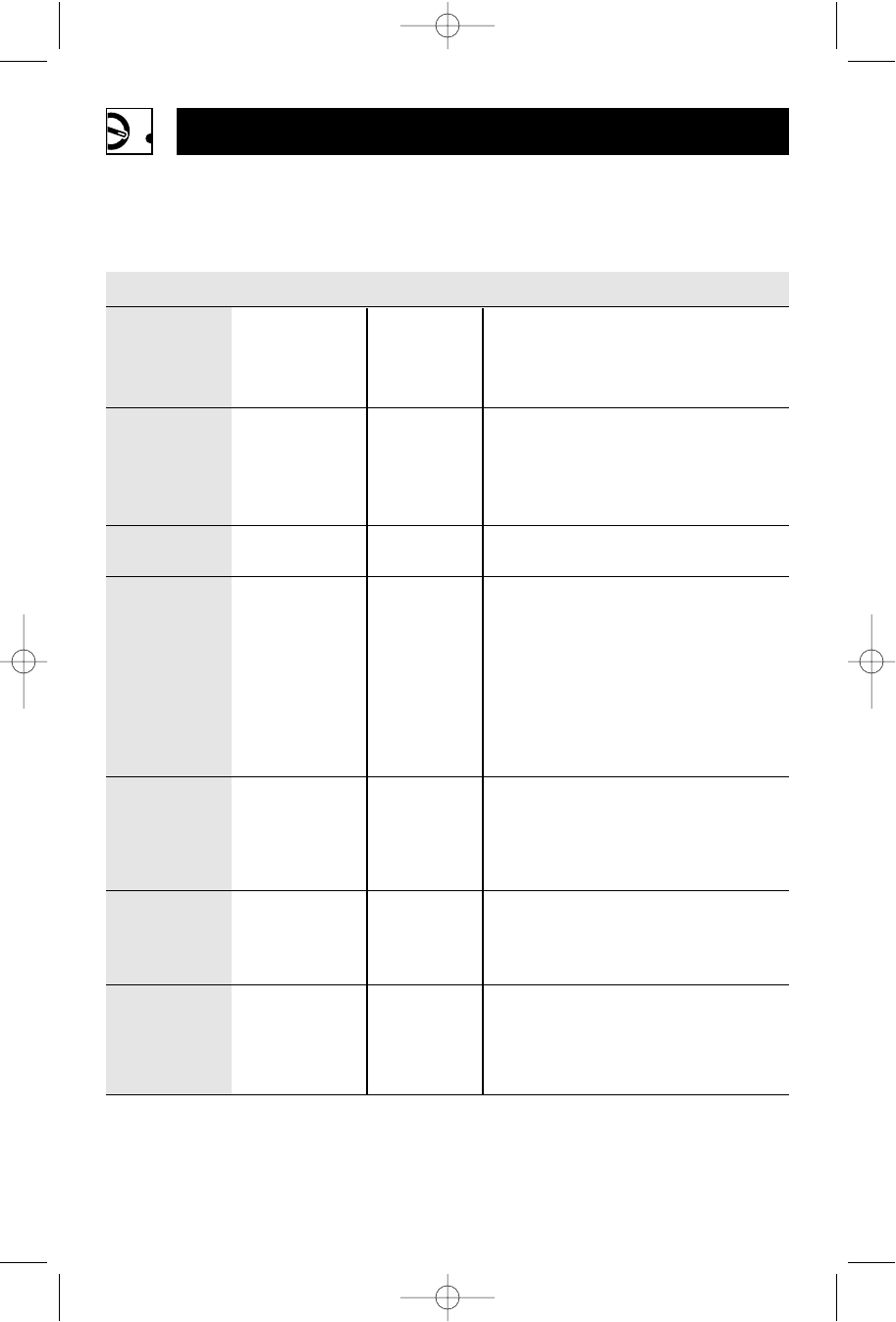
16
Operating Instructions
Cooking Guide for Time Cook I &II
NOTE: Use power level High (10) unless otherwise noted.
Vegetable Amount Time Comments
Asparagus
(fresh spears) 1 lb. 6 to 9 min., In 1
1
⁄
2
-qt. oblong glass baking dish,
Med-High (7) place 1/4 cup water.
(frozen spears) 10-oz. package 5 to 7 min. In 1-qt. casserole.
Beans
(fresh green) 1 lb. cut in half 9 to 11 min. In 1
1
⁄
2
-qt. casserole, place 1/2 cup water.
(frozen green) 10-oz. package 6 to 8 min. In 1-qt. casserole, place 2 tablespoons
water.
(frozen lima) 10-oz. package 6 to 8 min. In 1-qt. casserole, place 1/4 cup water.
Beets
(fresh, whole) 1 bunch 17 to 21 min. In 2-qt. casserole, place 1/2 cup water.
Broccoli
(fresh cut) 1 bunch 7 to 10 min. In 2-qt. casserole, place 1/2 cup water.
(1
1
⁄
4
to 1
1
⁄
2
lbs.)
(fresh spears) 1 bunch 9 to 13 min. In 2-qt. oblong glass baking dish, place
(1
1
⁄
4
to 1
1
⁄
2
lbs.) 1/4 cup water.
(frozen, 10-oz. package 5 to 7 min. In 1-qt. casserole.
chopped)
(frozen spears) 10-oz. package 5 to 7 min. In 1-qt. casserole, place 3 tablespoons
water.
Cabbage
(fresh) 1 medium head 8 to 11 min. In 1
1
⁄
2
- or 2-qt. casserole, place 1/4 cup
(about 2 lbs.) water.
(wedges) 7 to 10 min. In 2- or 3-qt. casserole, place 1/4 cup
water.
Carrots
(fresh, sliced) 1 lb. 7 to 9 min. In 1
1
⁄
2
-qt. casserole, place 1/4 cup water.
(frozen) 10-oz. package 5 to 7 min. In 1-qt. casserole, place 2 tablespoons
water.
Cauliflower
(flowerets) 1 medium head 9 to 14 min. In 2-qt. casserole, place 1/2 cup water.
(fresh, whole) 1 medium head 10 to 17 min. In 2-qt. casserole, place 1/2 cup water.
(frozen) 10-oz. package 5 to 7 min. In 1-qt. casserole, place 2 tablespoons
water.
39-40427v06 6/1/04 4:15 PM Page 16
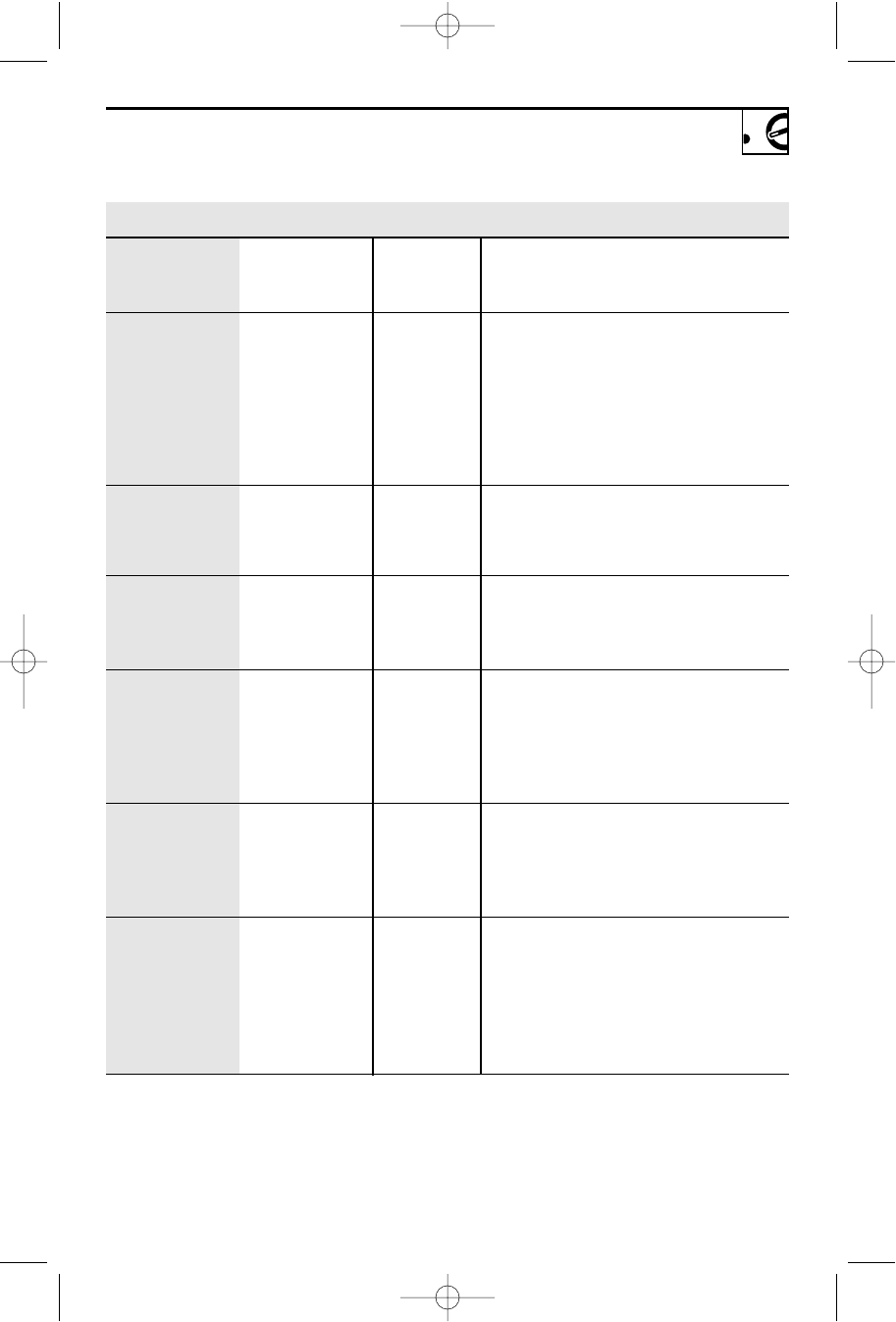
17
Vegetable Amount Time Comments
Corn
(frozen kernel) 10-oz. package 5 to 7 min. In 1-qt. casserole, place 2 tablespoons
water.
Corn on the cob
(fresh) 1 to 5 ears 3 to 4 min. In 2-qt. oblong glass baking dish, place
per ear corn. If corn is in husk, use no water;
if corn has been husked, add 1/4 cup
water. Rearrange after half of time.
(frozen) 1 ear 5 to 6 min. Place in 2-qt. oblong glass baking dish.
2 to 6 ears 3 to 4 min. Cover with vented plastic wrap.
per ear Rearrange after half of time.
Mixed
vegetables
(frozen) 10-oz. package 5 to 7 min. In 1-qt. casserole, place 3 tablespoons
water.
Peas
(fresh, shelled) 2 lbs. unshelled
9 to 12 min.
In 1-qt. casserole, place 1/4 cup water.
(frozen) 10-oz. package 5 to 7 min. In 1-qt. casserole, place 2 tablespoons
water.
Potatoes
(fresh, cubed, 4 potatoes
9 to 12 min.
Peel and cut into 1 inch cubes. Place
white) (6 to 8 oz. each) in 2-qt. casserole with 1/2 cup water.
Stir after half of time.
(fresh, whole, 1 (6 to 8 oz.) 3 to 4 min. Pierce with cooking fork. Place in
sweet or white) center of the oven. Let stand 5 minutes.
Spinach
(fresh) 10 to 16 oz. 5 to 7 min. In 2-qt. casserole, place washed spinach.
(frozen, 10-oz. package 5 to 7 min. In 1-qt. casserole, place 3 tablespoons
chopped water.
and leaf)
Squash
(fresh, summer 1 lb. sliced 5 to 7 min. In 11⁄2-qt. casserole, place 1/4 cup water.
and yellow)
(winter, acorn 1 to 2 squash 8 to 11 min. Cut in half and remove fibrous
butternut)
(about 1 lb. each)
membranes. In 2-qt. oblong glass
baking dish, place squash cut-side-
down. Turn cut-side-up after 4 minutes.
39-40427v06 6/1/04 4:15 PM Page 17
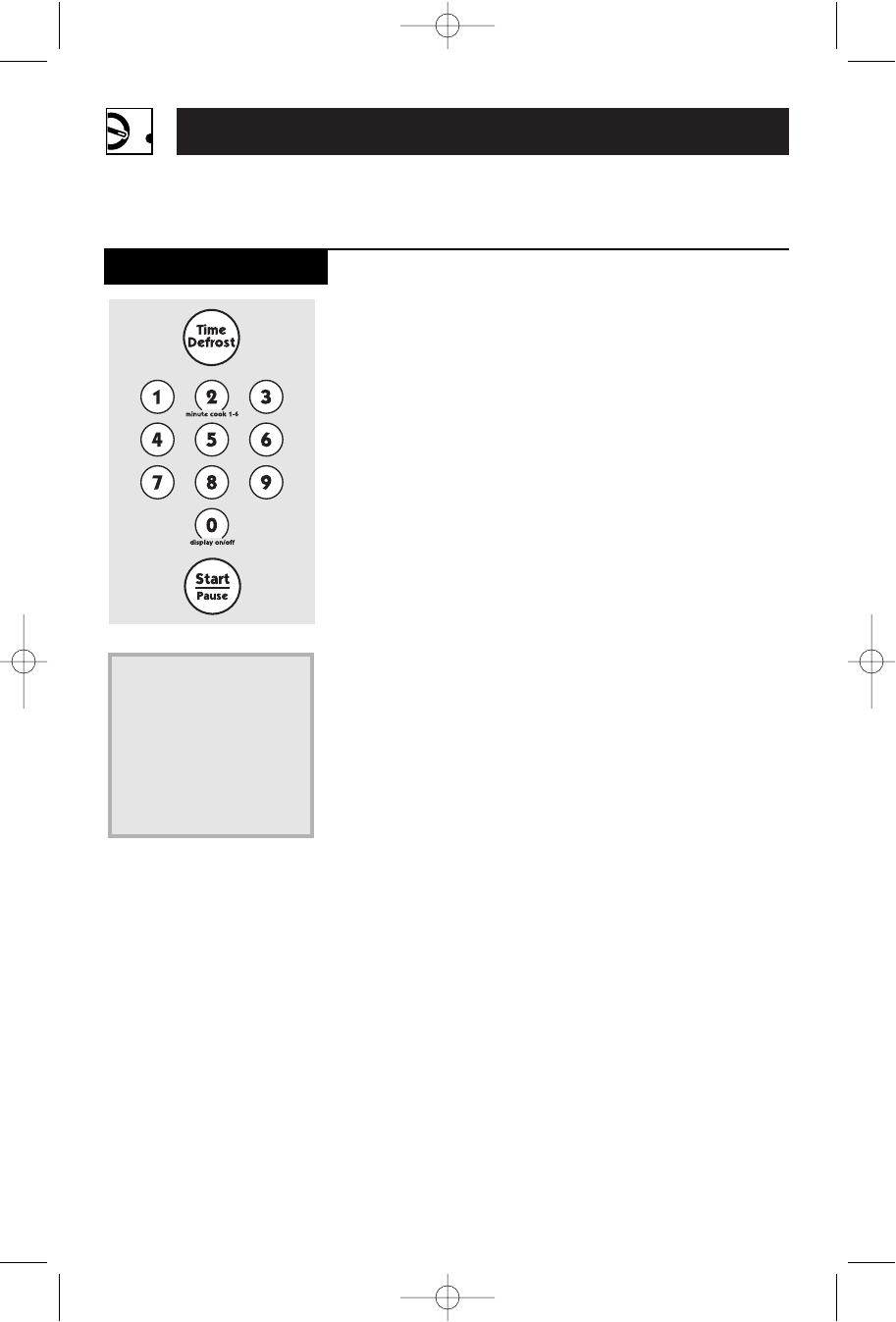
Operating Instructions
Time Features
Allows you to defrost for the
length of time you select.
See the Defrosting Guide
for suggested times.
Power level 3 is automatically
set, but you may change this
for more flexibility.
You may defrost small items
more quickly by raising the
power level after entering
the time. However, they
will need more frequent
attention than usual.
Power level 7 cuts the total
defrosting time in about
half; power level 10 cuts the
total time to approximately
1/3. Rotate or stir food
frequently.
At one half of selected
defrosting time, turn food
over and break apart or
rearrange pieces for more
even defrosting. Shield any
warm areas with small pieces
of foil.
A dull thumping noise may
be heard during defrosting.
This sound is normal when
the oven is not operating at
High power.
Defrosting Tips
•Foods frozen in paper or
plastic can be defrosted in
the package. Tightly closed
packages should be slit,
pierced or vented AFTER
food has partially
defrosted. Plastic storage
containers should be at
least partially uncovered.
•Family-size, prepackaged
frozen dinners can be
defrosted and microwaved.
If the food is in a foil
container, transfer it
to a microwave-safe dish.
•Foods that spoil easily, such
as milk, eggs, fish, stuffings,
poultry and pork, should
not be allowed to sit out
for more than one hour
after defrosting. Room
temperature promotes
the growth of harmful
bacteria.
•For more even defrosting
of larger foods, such as
beef, lamb and veal roasts,
use Auto Defrost.
•Be sure large meats are
completely defrosted
before cooking.
•When defrosted, food
should be cool but
softened in all areas. If still
slightly icy, return to the
microwave very briefly, or
let it stand a few minutes.
Time Defrost
18
1 Press TIME DEFROST.
2 Enter defrosting time.
3 Press START.
(Auto Defrost explained
in the section on
Convenience Features.)
39-40427v06 6/1/04 4:15 PM Page 18
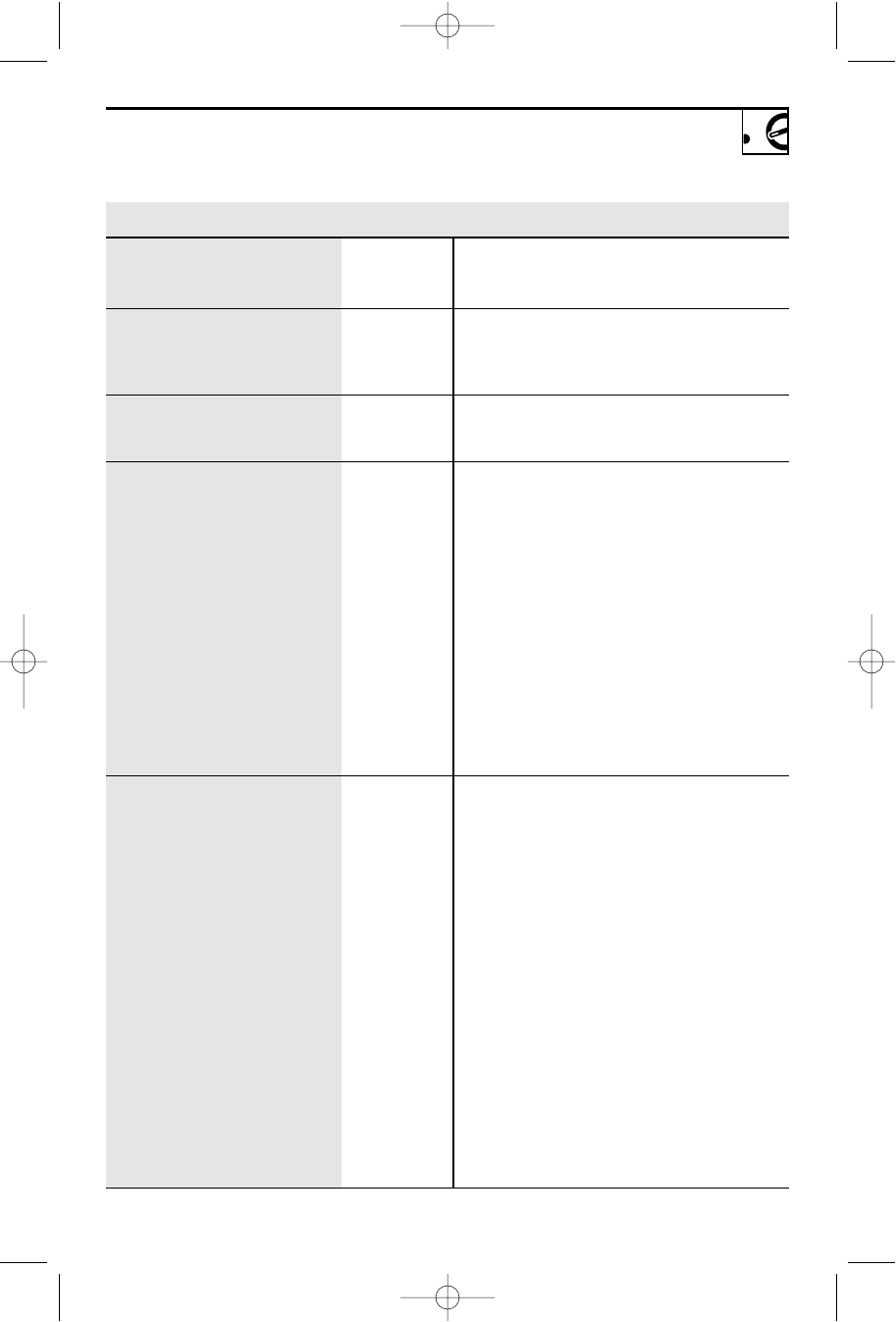
Defrosting Guide
Food Time Comments
Breads, Cakes
Bread, buns or rolls (1 piece) 1 min.
Sweet rolls (approx. 12 oz.) 3 to 5 min.
Fish and Seafood
Fillets, frozen (1 lb.) 6 to 8 min.
Shellfish, small pieces (1 lb.) 5 to 7 min. Place block in casserole. Turn over and
break up after half the time.
Fruit
Plastic pouch—1 to 2 3 to 6 min.
(10-oz. package)
Meat
Bacon (1 lb.) 2 to 5 min. Place unopened package in oven.
Let stand 5 minutes after defrosting.
Franks (1 lb.) 2 to 5 min. Place unopened package in oven.
Microwave just until franks can be
separated. Let stand 5 minutes,
if necessary, to complete defrosting.
Ground meat (1 lb.) 5 to 7 min. Turn meat over after half the time.
Roast: beef, lamb, veal, pork 12 to 16 min. Use power level 1.
per lb.
Steaks, chops and cutlets 5 to 7 min. Place unwrapped meat in cooking dish.
per lb. Turn over after half the time and shield
warm areas with foil. When finished,
separate pieces and let stand to complete
defrosting.
Poultry
Chicken, broiler-fryer 15 to 19 min. Place wrapped chicken in dish. Unwrap
cut up (21⁄2to 3 lbs.) and turn over after half the time. When
finished, separate pieces and microwave
2–4 minutes more, if necessary.
Let stand to finish defrosting.
Chicken, whole 17 to 21 min. Place wrapped chicken in dish. After half
(21⁄2to 3 lbs.) the time, unwrap and turn chicken over.
Shield warm areas with foil. Finish
defrosting. If necessary, run cold water in
the cavity until giblets can be removed.
Cornish hen 7 to 13 min. Place unwrapped hen in the oven breast-
per lb. side-up. Turn over after half the time.
Run cool water in the cavity until giblets
can be removed.
Turkey breast (4 to 6 lbs.) 5 to 9 min. Place unwrapped breast in dish breast-
per lb. side-down. After half the time, turn over
and shield warm areas with foil. Finish
defrosting. Let stand 1–2 hours in
refrigerator to complete defrosting.
19
39-40427v06 6/1/04 4:15 PM Page 19
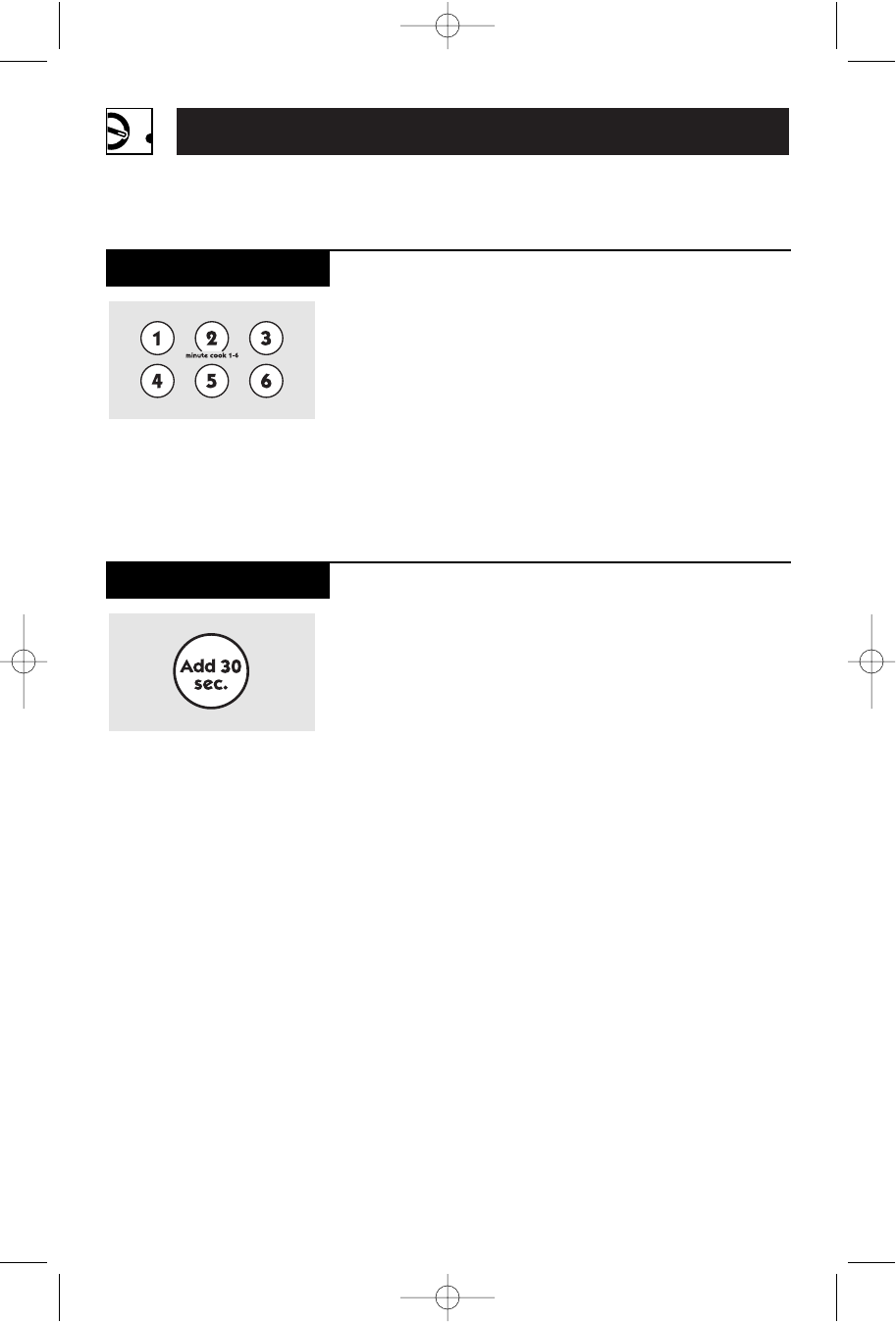
Operating Instructions
Time Features
You can use this feature
two ways:
•It will add 30 seconds to
the time counting down
each time the pad is
pressed.
•It can be used as a quick
way to set 30 seconds of
cooking time.
Add 30 Seconds
This is a quick way to set
cooking time for 1–6 minutes.
Press one of the Minute
Cook pads (from 1 to 6)
for 1 to 6 minutes of
cooking at power level 10.
For example, press the
2 pad for 2 minutes of
cooking time.
The power level can be
changed as time is
counting down. Press
POWER LEVEL and
enter 1–10.
Minute Cook
20
39-40427v06 6/1/04 4:15 PM Page 20
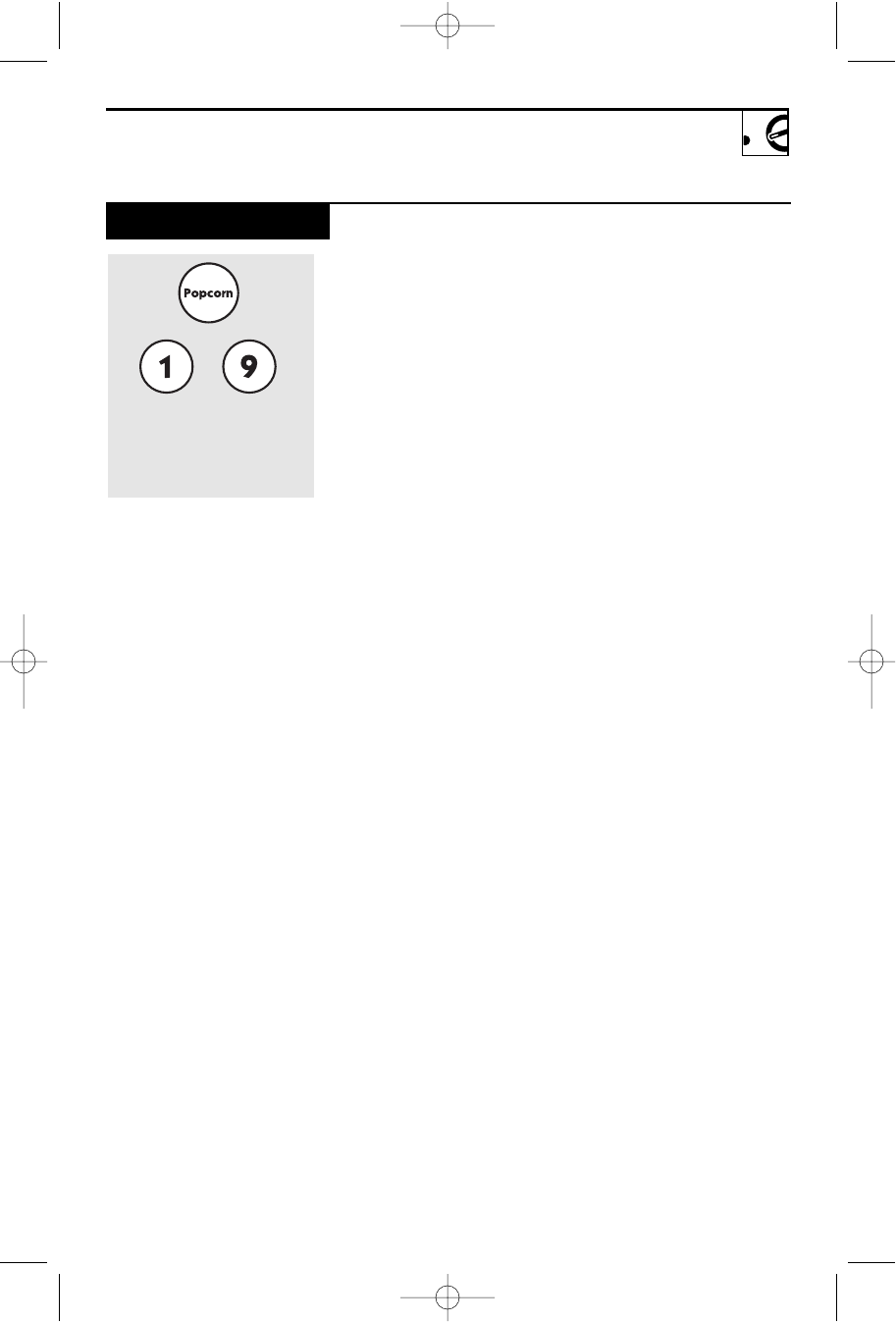
Convenience Features
21
How to Use the Popcorn
Feature
1Follow package
instructions, using Time
Cook if the package is
less than 3.0 ounces or
larger than 3.5 ounces.
Place the package of
popcorn in the center
of the microwave.
2Press POPCORN. The
oven starts immediately.
Tap POPCORN to select
the bag size you are
cooking.
How to Adjust the Popcorn
Program to Provide a Shorter
or Longer Cook Time
If you find that the brand of
popcorn you use underpops
or overcooks consistently,
you can add or subtract
20–30 seconds to the
automatic popping time.
To add time:
After pressing POPCORN,
press 9 immediately after
the oven starts for an extra
20 seconds.
To subtract time:
After pressing POPCORN,
press 1 immediately after
the oven starts for 20
seconds less cooking time.
Popcorn
(less time) (more time)
Use only with prepackaged
microwave popcorn weighing
3.0 to 3.5 ounces.
39-40427v06 6/1/04 4:15 PM Page 21
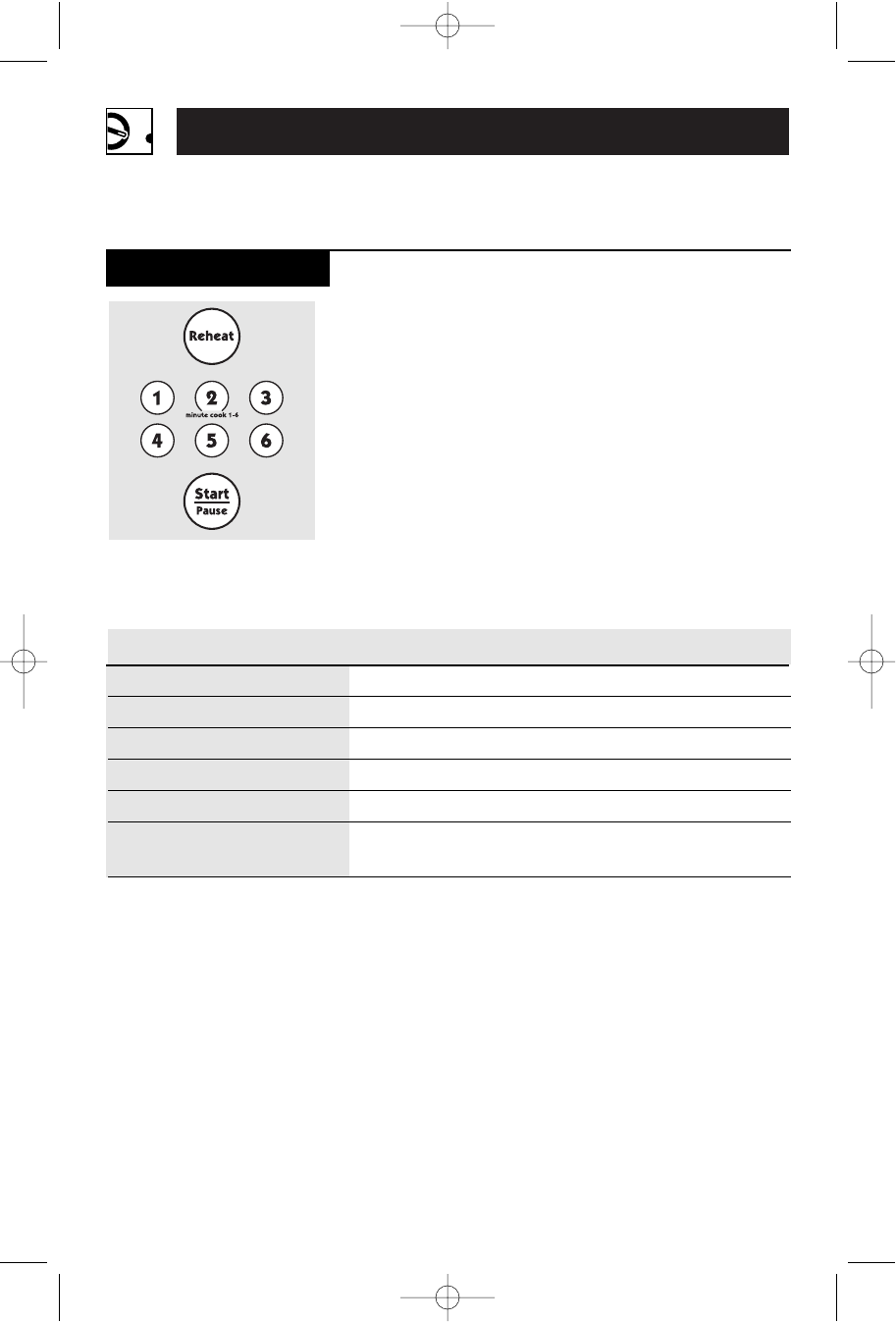
22
Operating Instructions
Convenience Features
The Reheat feature reheats
servings of many previously
cooked foods.
1Press REHEAT.
2Select food type 1–6 for
one serving (see Reheat
Guide below). The oven
starts immediately.
3Press 2 or 3 to change the
serving size.
NOTE: The serving size may
be changed or added after
the oven starts. Press
number pad 2 or 3.
The serving size for food
type 6 cannot be changed.
Reheat
1 Pasta Cover with lid or vented plastic wrap.
2 Meats, casseroles, pizza Cover with lid or vented plastic wrap.
3 Fruits and vegetables Cover with lid or vented plastic wrap.
4 Beverages, 8–10 oz. Works best with wide mouth mug—do not cover.
5 Sauces and gravies Cover with lid or vented plastic wrap.
6 Plate of leftovers Cover with vented plastic wrap.
(2–3 foods, 4 oz. each)
Food Type Comments
Reheat Guide
39-40427v06 6/1/04 4:15 PM Page 22

23
The Beverage feature
heats 4 ounce, 8 ounce
or 12 ounce servings of
any beverage.
Press BEVERAGE. The
oven starts immediately.
The serving size is
automatically set at
4 ounces, but can be
changed by tapping
BEVERAGE to select
8 or 12 ounces.
Drinks heated with the
Beverage feature may be
very hot. Remove the
container with care.
Beverage
39-40427v06 6/1/04 4:15 PM Page 23
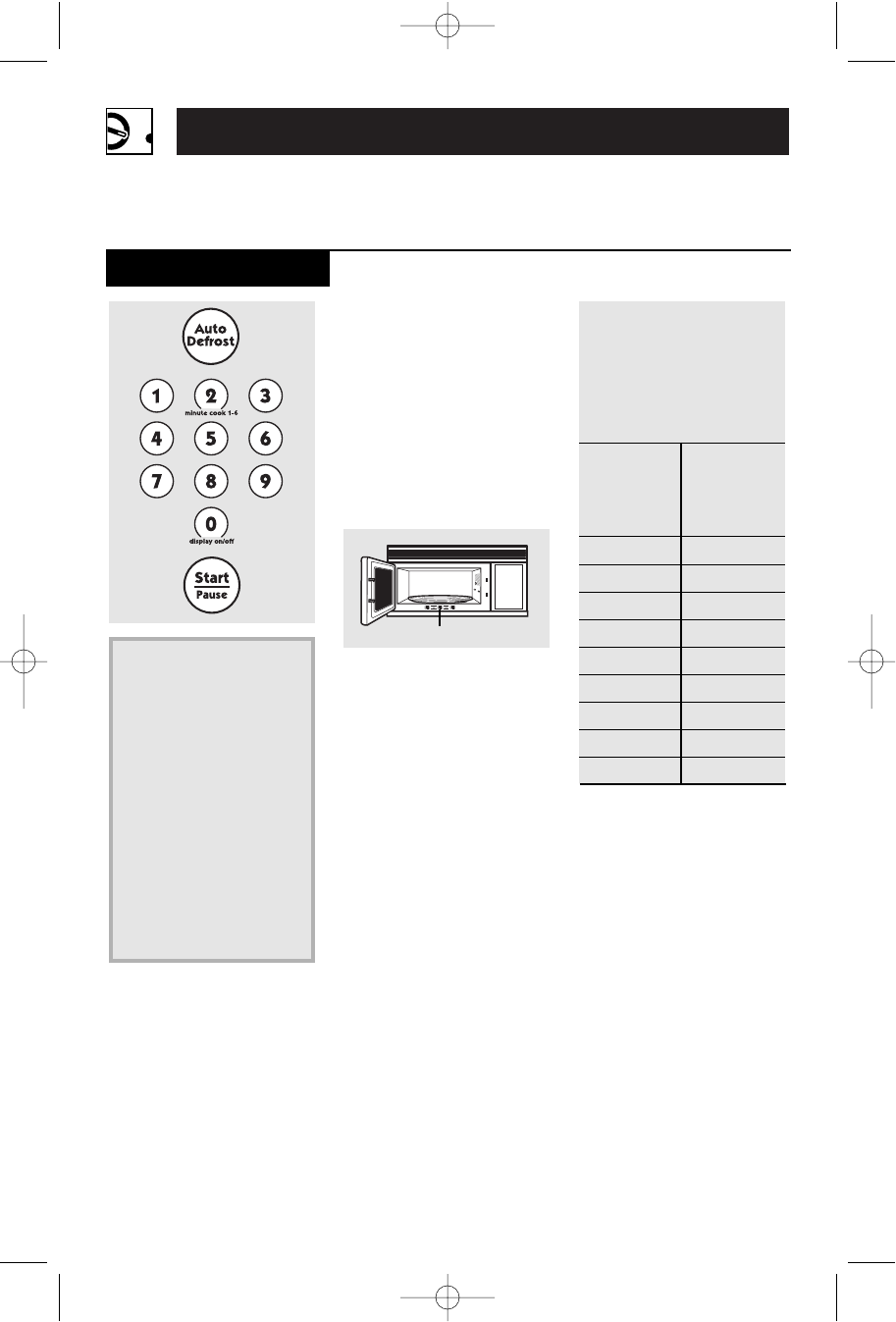
Operating Instructions
Convenience Features
Auto Defrost
Auto Defrost automatically
sets the defrosting times
and power levels to give
even defrosting results for
meats, poultry and fish
weighing up to six pounds.
There is a handy guide
located on the inside front
of the oven.
•Remove meat from
package and place on
microwave-safe dish.
•Twice during defrost,
the oven signals TURN.
At each TURN signal,
turn the food over.
Remove defrosted meat
or shield warm areas with
small pieces of foil.
•After defrosting, most
meats need to stand
5 minutes to complete
defrosting. Large roasts
should stand for about
30 minutes.
Conversion Guide
If the weight of food is
stated in pounds and
ounces, the ounces must
be converted to tenths
(.1) of a pound.
Weight of Enter Food
Food in Weight
Ounces (tenths of
a pound)
1–2 .1
3.2
4–5 .3
6–7 .4
8.5
9–10 .6
11 .7
12–13 .8
14–15 .9
1 Press AUTO DEFROST.
2 Using the Conversion
Guide at right, enter
food weight. For
example, press pads 1
and 2 for 1.2 pounds
(1 pound, 3 ounces).
3 Press START.
(Time Defrost is
explained in the Time
Features section.)
Guide
24
39-40427v06 6/1/04 4:16 PM Page 24
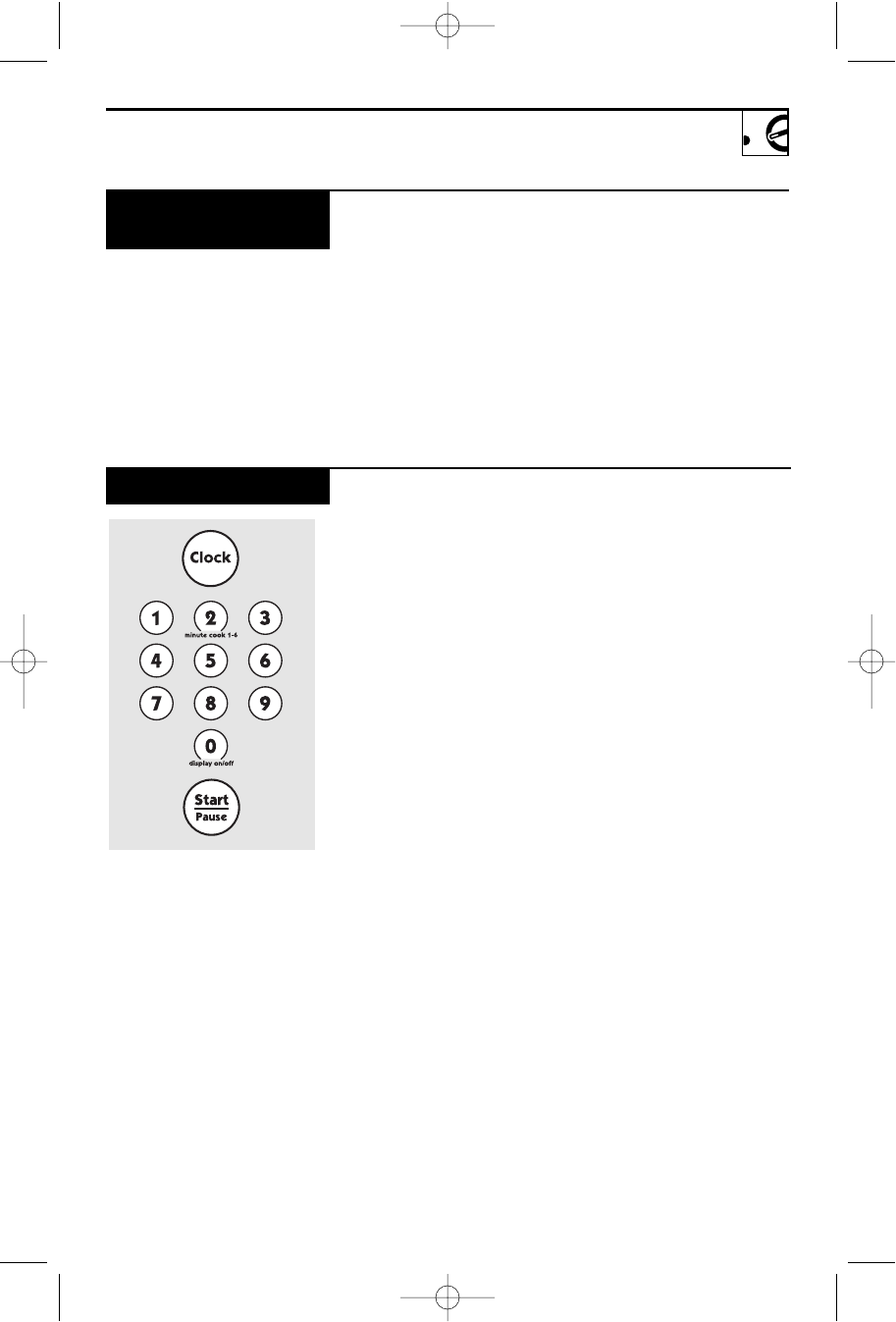
Other Features Your Model May Have
25
To remind you that you
have food in the oven, the
oven will display “END”
and beep once a minute
until you either open the
oven door or press
CLEAR/OFF.
Cooking Complete
Reminder
Press to enter the time of
day or to check the time of
day while microwaving.
1Press CLOCK.
2Enter time of day.
3Press START or CLOCK.
Clock
39-40427v06 6/1/04 4:16 PM Page 25
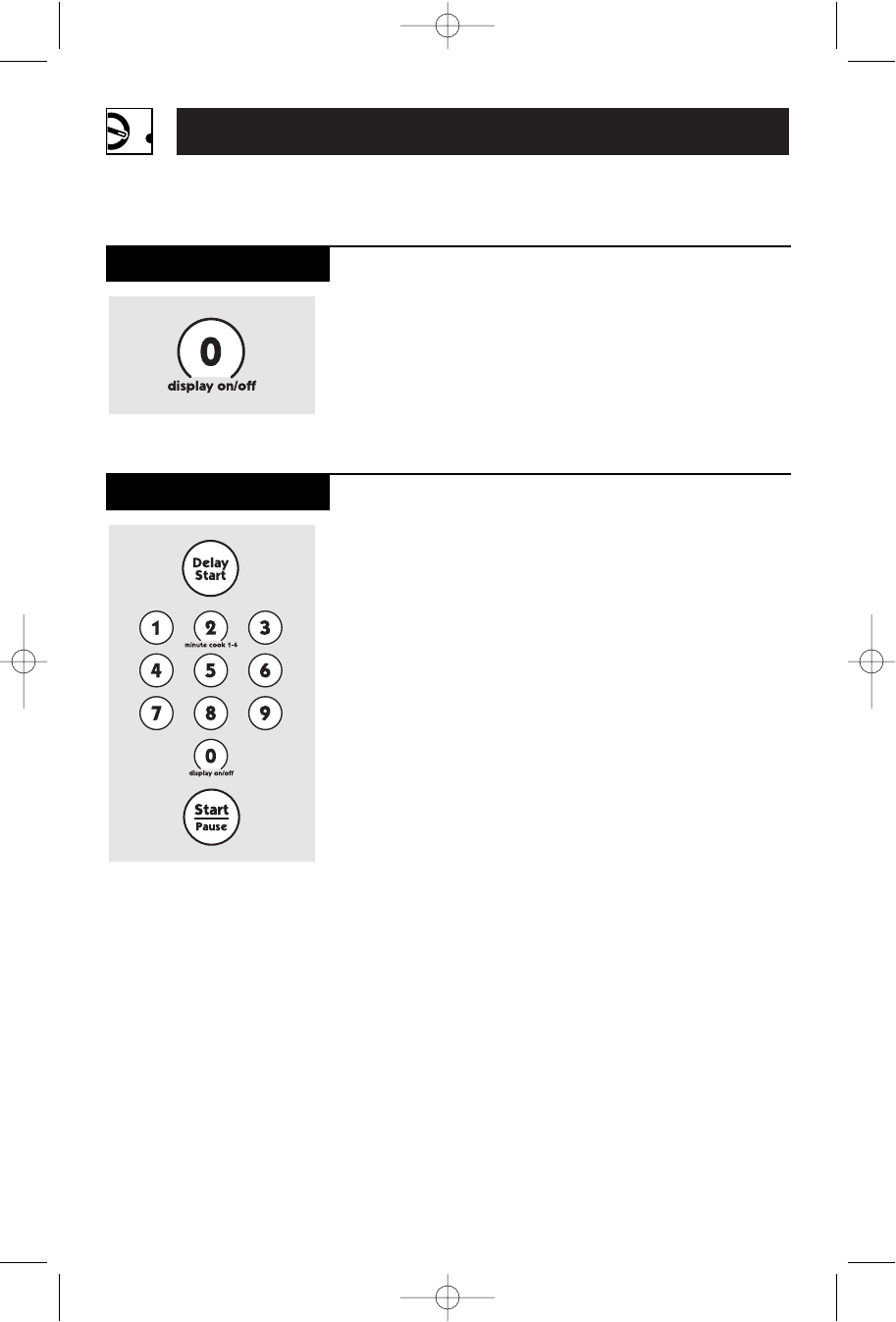
Operating Instructions
Other Features Your Model May Have
To turn the clock display
off, press and hold 0 for
about three seconds.
To redisplay the clock,
repeat.
Display On/Off
Delay Start allows you to
set the microwave to delay
cooking up to 24 hours.
1Press DELAY START.
2Enter the time you
want the oven to start.
(Be sure the microwave
clock shows the correct
time of day.)
3Select any combination
of Auto or Time Defrost
or Time Cook I & II.
4Press START.
The Delay Start time will
be displayed. The oven will
automatically start at the
delayed time.
The time of day may be
displayed by pressing
CLOCK.
Delay Start
26
39-40427v06 6/1/04 4:16 PM Page 26
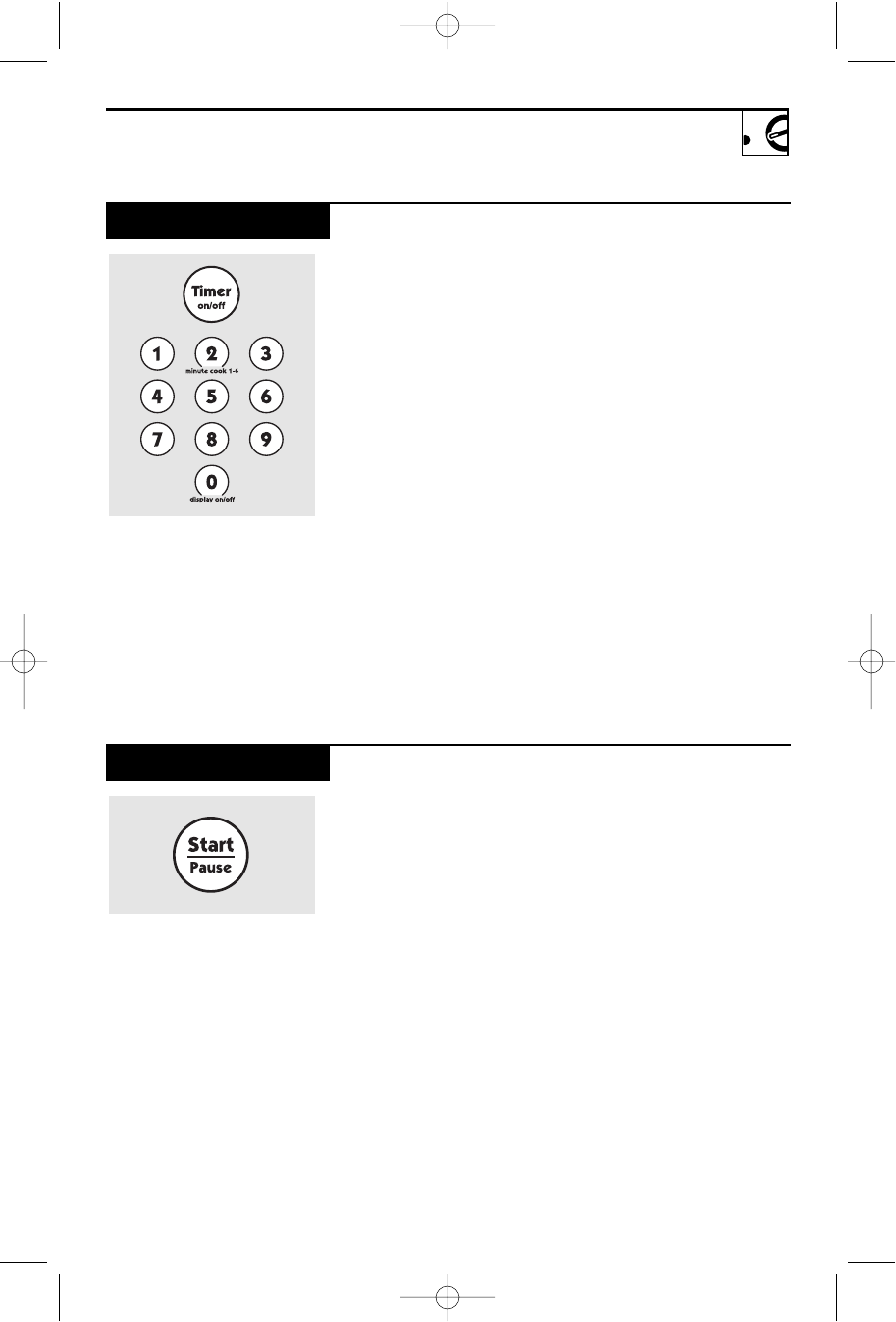
27
In addition to starting many
functions, START/PAUSE
allows you to stop cooking
without opening the door
or clearing the display.
Start/Pause
Timer On/Off operates as
a minute timer and can be
used at any time, even
when the oven is operating.
To use the timer as a
minute timer when the
oven is not operating:
1Press TIMER ON/OFF.
2Enter the time you want
to count down.
3Press TIMER ON/OFF
to start.
When time is up, the oven
will signal.
NOTE: The timer indicator
will be lit while the timer
is operating.
To use the timer while the
oven is operating:
1Press TIMER ON/OFF.
2Enter the time you want
to count down.
3Press START/PAUSE
to start.
When time is up, the oven
will signal. To turn off the
timer signal, press TIMER
ON/OFF.
Timer On/Off
39-40427v06 6/1/04 4:16 PM Page 27

Operating Instructions
Other Features Your Model May Have
You may lock the control
panel to prevent the
microwave from being
accidentally started or used
by children.
To lock or unlock the
controls, press and hold
CLEAR/OFF for about
three seconds. When the
control panel is locked,
“LOC” will be displayed.
Child Lock-Out
28
39-40427v06 6/1/04 4:16 PM Page 28

When the microwave oven
is off, you may operate the
vent fan:
1Press the Vent Fan pad
once for high fan speed.
2Press the Vent Fan pad a
second time for low fan
speed.
3Press the Vent Fan pad
a third time to turn the
fan off.
When the microwave is
on, the vent fan will
automatically turn on at
low fan speed, stay on while
the microwave is operating
and automatically turn off
after the microwave goes
off if the Vent Fan pad is
not pressed.
When the microwave oven
is on you may also:
1Press the Vent Fan pad
once for high fan speed.
2Press the Vent Fan pad a
second time for low fan
speed.
3Press the Vent Fan pad
a third time to set the fan
to turn off automatically
after the microwave
goes off.
If the vent fan is still
operating after the
microwave goes off, press
the Vent Fan pad until it
turns off.
NOTE: The vent fan cannot
be turned off while the
microwave is operating.
Vent Fan
Press to turn the surface
light on or off.
Surface Light
The vent fan removes steam and
other vapors from surface
cooking and cools internal parts
in the microwave oven.
29
39-40427v06 6/1/04 4:16 PM Page 29
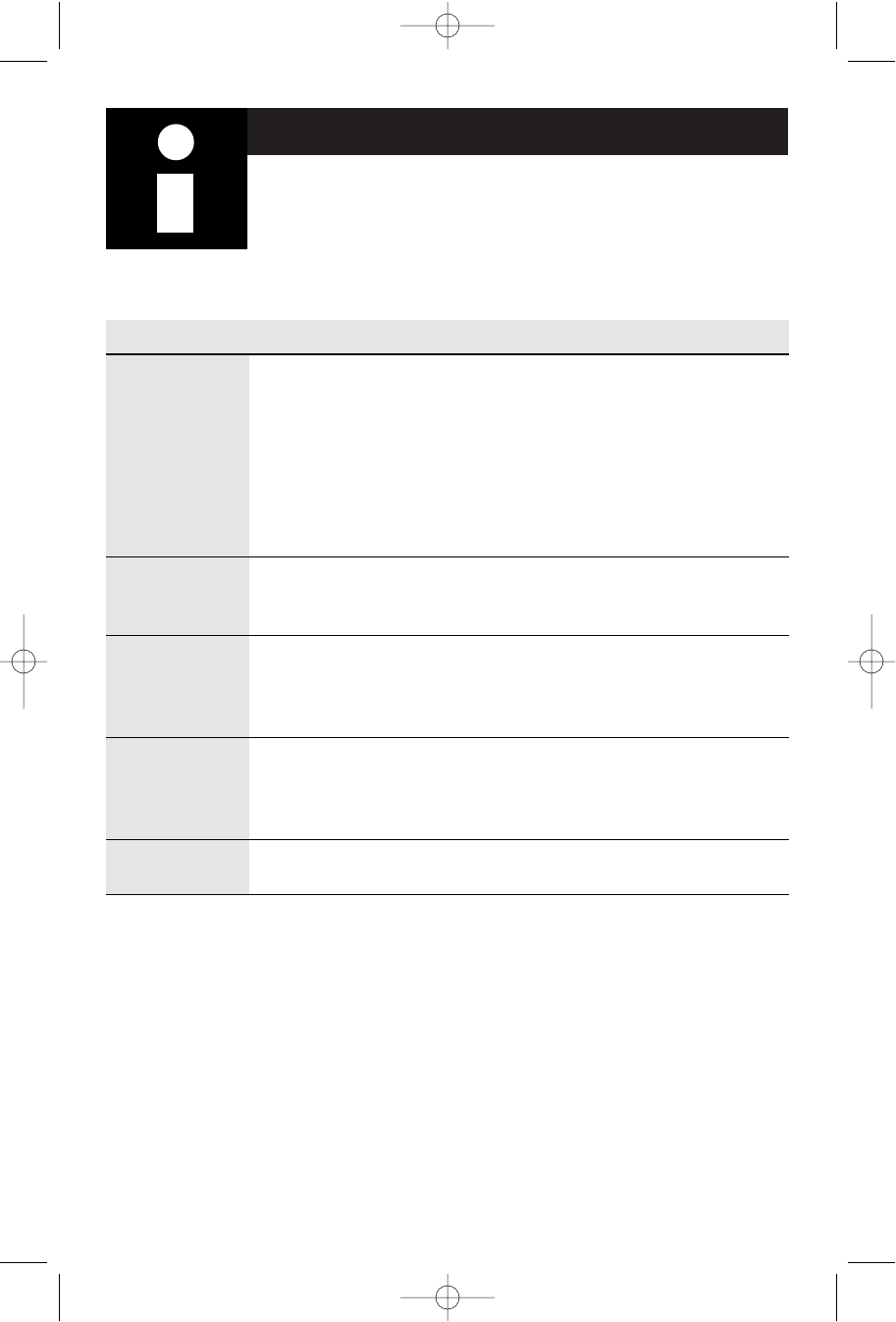
30
Helpful Information
Microwave Terms
Arcing Arcing is the microwave term for sparks in the oven. Arcing is
caused by:
•metal or foil touching the side of the oven.
•foil that is not molded to food (upturned edges act like
antennas).
•metal such as twist ties, poultry pins, gold-rimmed dishes.
•recycled paper towels containing small metal pieces.
Covering Covers hold in moisture, allow for more even heating and reduce
cooking time. Venting plastic wrap or covering with wax paper
allows excess steam to escape.
Shielding In a regular oven, you shield chicken breasts or baked foods to
prevent over-browning. When microwaving, you use small strips of
foil to shield thin parts, such as the tips of wings and legs on
poultry, which would cook before larger parts.
Standing Time When you cook with regular ovens, foods such as roasts or cakes are
allowed to stand to finish cooking or to set. Standing time is
especially important in microwave cooking. Note that a microwaved
cake is not placed on a cooling rack.
Venting After covering a dish with plastic wrap, you vent the plastic wrap by
turning back one corner so excess steam can escape.
Term Definition
39-40427v06 6/1/04 4:16 PM Page 30

31
Care and Cleaning
An occasional thorough
wiping with a solution of
baking soda and water
keeps the inside fresh.
NOTE: Be certain the power
is off before cleaning any
part of this oven.
Helpful Hints
Walls, Floor, Inside Window,
Metal and Plastic Parts on
the Door
Some spatters can be
removed with a paper
towel; others may require
a damp cloth. Remove
greasy spatters with a sudsy
cloth, then rinse with a
damp cloth. Do not use
abrasive cleaners or sharp
utensils on oven walls.
Never use a commercial
oven cleaner on any part
of your microwave.
Removable Turntable and
Turntable Support
To prevent breakage,
do not place the turntable
into water just after
cooking. Wash it carefully
in warm, sudsy water or
in the dishwasher. The
turntable and support
can be broken if dropped.
Remember, do not operate
the oven without the
turntable and support
in place.
How to Clean
the Inside
39-40427v06 6/1/04 4:16 PM Page 31
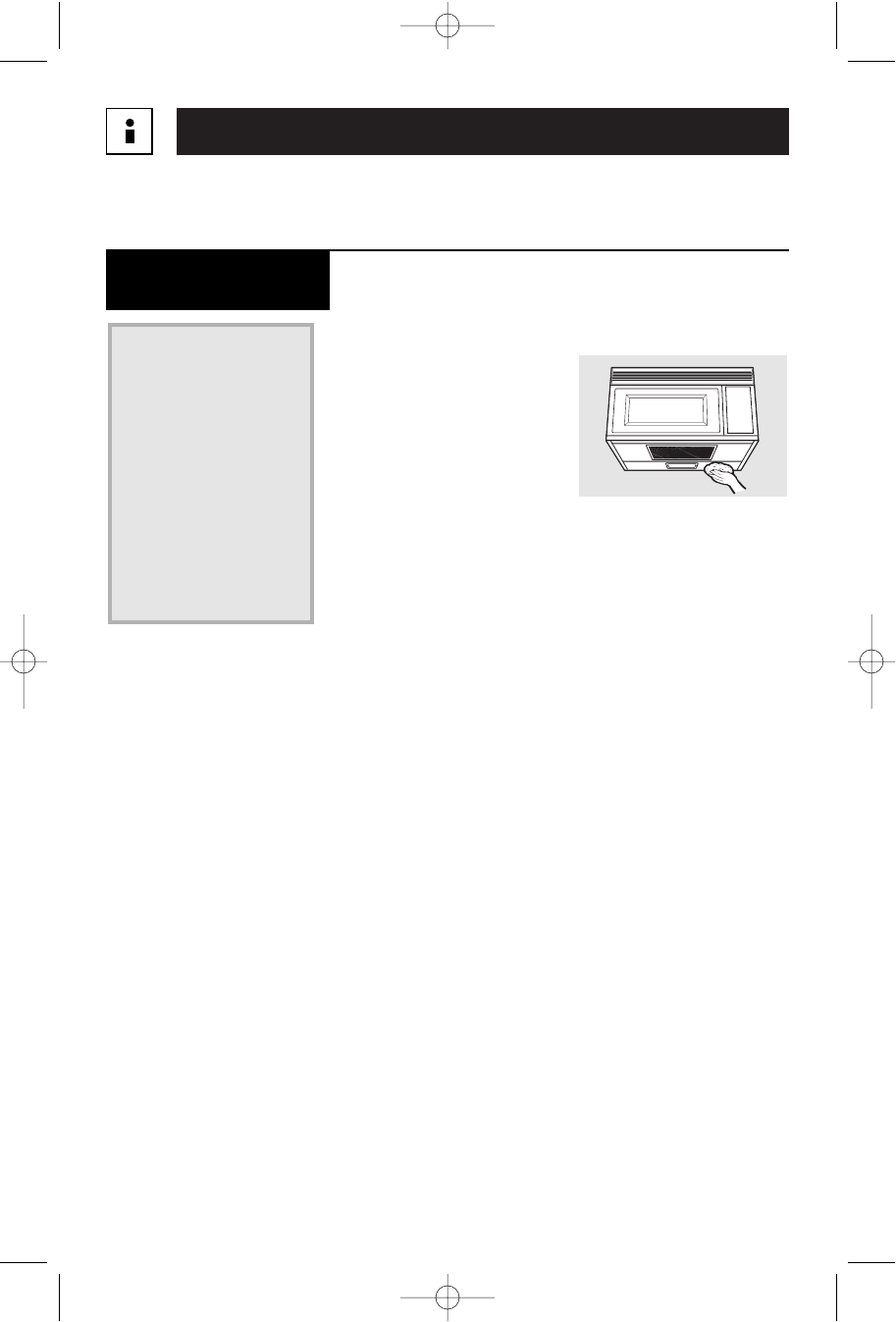
Helpful Information
Care and Cleaning
32
Case
Clean the outside of the
microwave with a sudsy
cloth. Rinse and then dry.
Wipe the window clean
with a damp cloth.
Control Panel and Door
Wipe with a damp cloth.
Dry thoroughly. Do not
use cleaning sprays, large
amounts of soap and water,
abrasives or sharp objects
on the panel—they can
damage it. Some paper
towels can also scratch
the control panel.
Door Seal
It’s important to keep
the area clean where the
door seals against the
microwave. Use only mild,
non-abrasive detergents
applied with a clean
sponge or soft cloth.
Rinse well.
Bottom
Clean off the grease and
dust on the bottom often.
Use a solution of warm
water and detergent.
We recommend against
using cleaners with
ammonia or alcohol, as
they can damage the
appearance of the
microwave oven. If you
choose to use a common
household cleaner, first
apply the cleaner
directly to a clean cloth,
then wipe the soiled
area.
How to Clean
the Outside
39-40427v06 6/1/04 4:16 PM Page 32
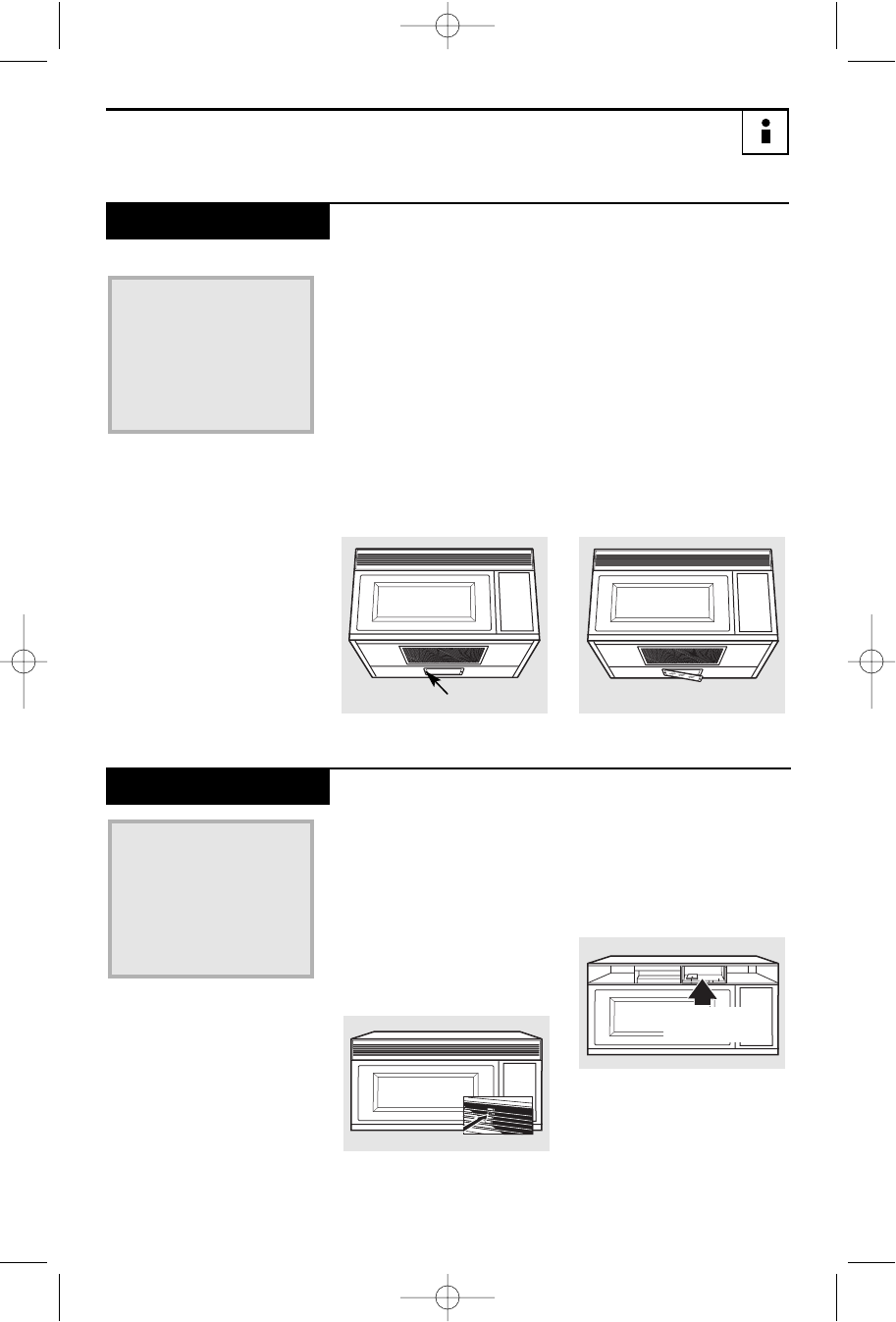
Light Bulb Replacement
1To replace the bulb, first
disconnect the power at
the main fuse or circuit
breaker panel or pull
the plug.
2Remove the screw from
light cover and lower
the cover.
3Be sure the bulb is cool
before removing. After
breaking the adhesive
seal, remove the bulb by
gently turning.
4Replace the bulb. Close
the light cover and
secure the cover with the
screw. Connect electrical
power to the oven.
Replace the burned-out
bulb with a 40-watt
incandescent bulb
(WB36X10003), available
from your Hotpoint
supplier.
Cooktop Light
1To replace the oven light,
first disconnect the power
at the main fuse or circuit
breaker panel or pull
the plug.
2Remove the top grille by
taking out the 3 screws
that hold it in place.
3Reach into the opening
just right of center.
Locate and remove the
bulb by turning gently.
Install replacement bulb.
4Connect electrical power
to the oven.
Replace the burned-out
bulb with a 40-watt
incandescent bulb
(WB36X10003), available
from your Hotpoint
supplier.
Oven Light
33
REMOVE SCREW
Interior Light
Housing
39-40427v06 6/1/04 4:16 PM Page 33
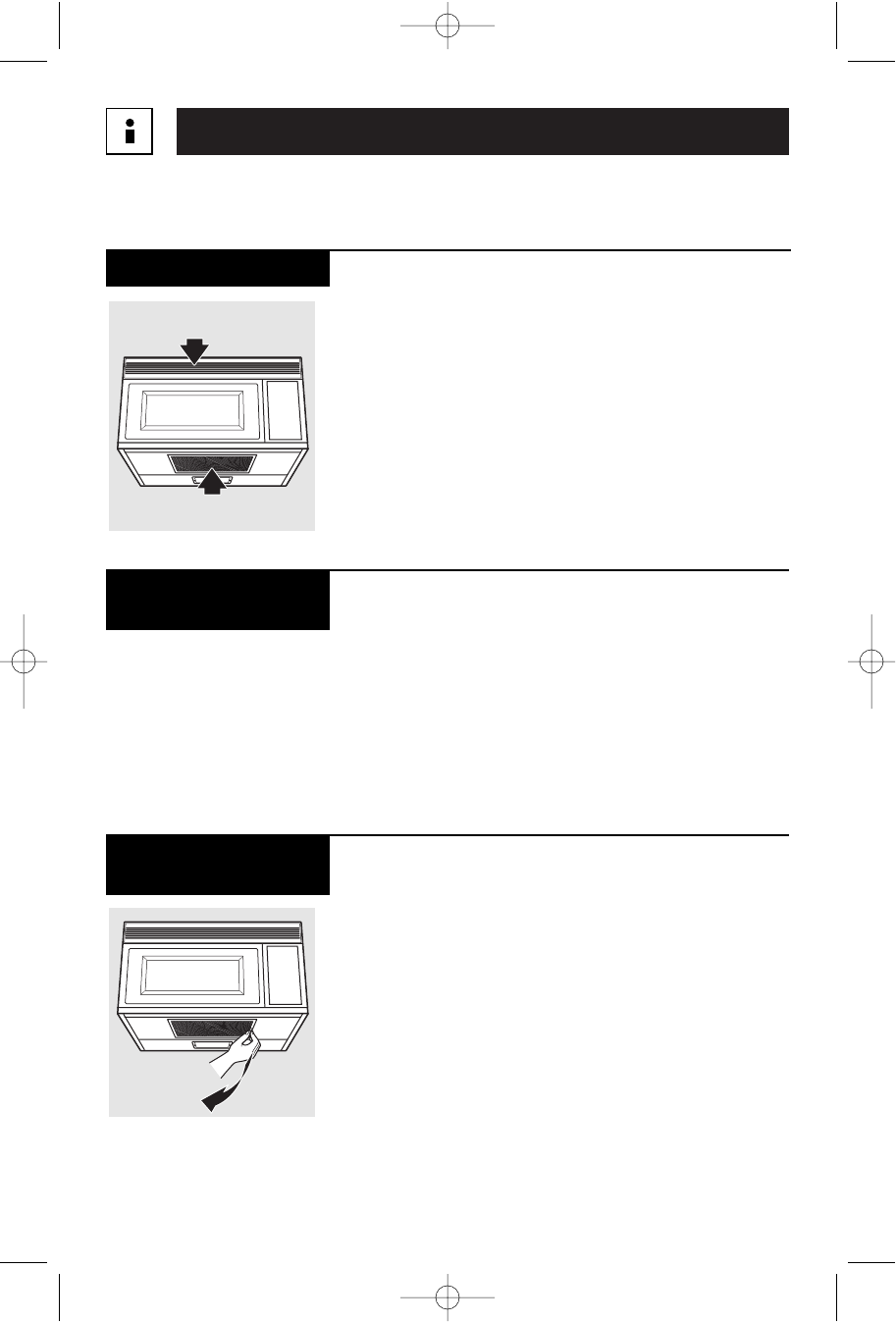
Helpful Information
The Exhaust Feature
The vent fan has a metal
reusable grease filter.
Models that recirculate air
back into the room also
use a charcoal filter.
The Vent Fan
Charcoal Filter
(on some models)
Reusable Grease Filter
The metal filter traps
grease released by foods
on the cooktop. It also
prevents flames from foods
on the cooktop from
damaging the inside of
the microwave.
For this reason, the filter
must ALWAYS be in place
when the hood is used.
The grease filter should be
cleaned once a month, or
as needed.
Reusable Grease
Filter
To remove, grasp the loop
and slide the filter to the
left side. Pull the filter
down and out.
To clean the grease filter,
soak it and then swish it
around in hot water and
detergent. Don’t use
ammonia or ammonia
products because they will
darken the metal. Light
brushing can be used to
remove embedded dirt.
Rinse, shake and let it dry
before replacing.
To replace, slide the filter
into the left side of the
opening and pull toward
the right.
Removing and
Cleaning the Filter
34
39-40427v06 6/1/04 4:16 PM Page 34
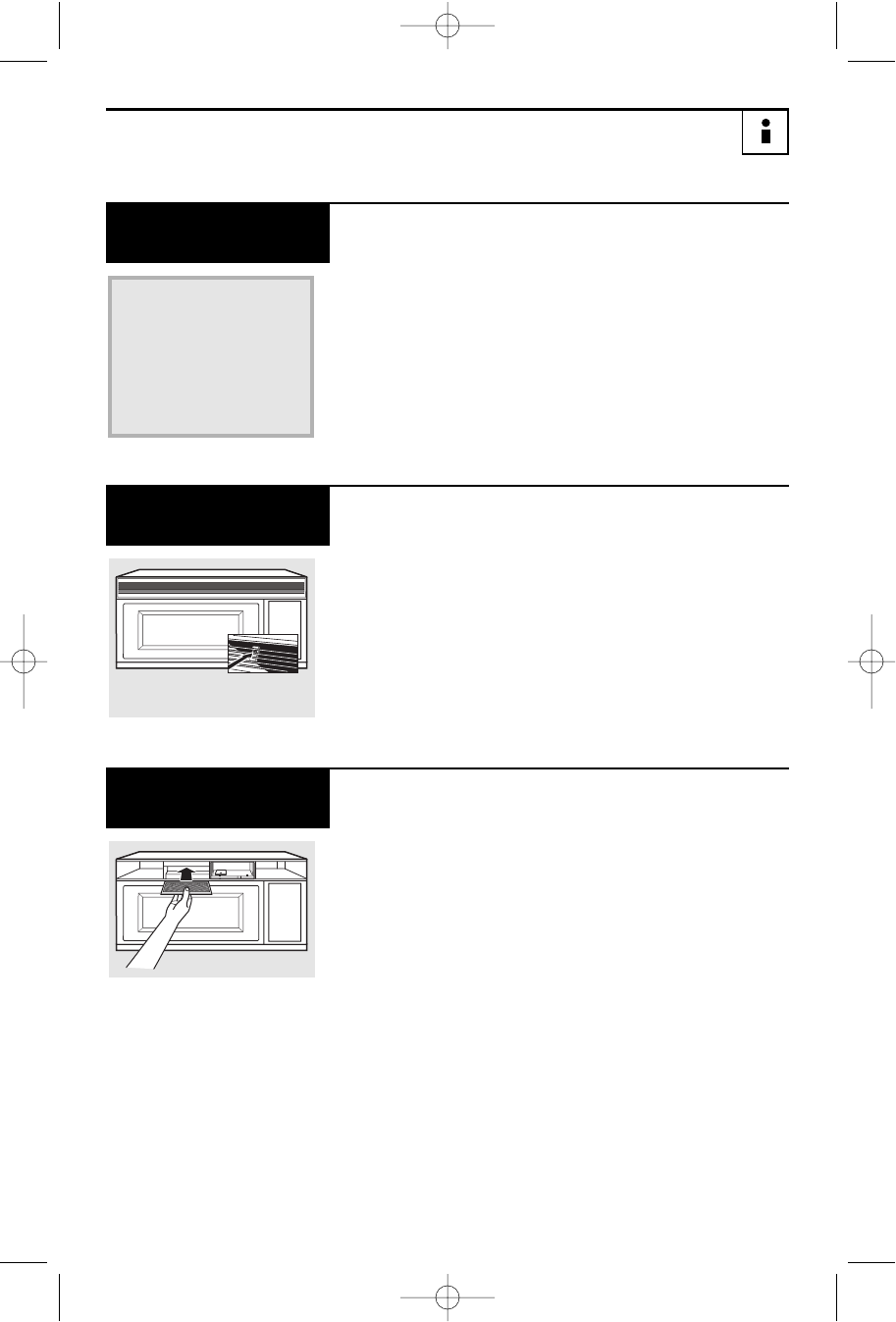
35
If the model is not vented
to the outside, the air will
be recirculated through a
disposable charcoal filter
that helps remove smoke
and odors.
The charcoal filter
should be replaced when
it is noticeably dirty or
discolored (usually after
6–12 months, depending
on hood usage).
The charcoal filter
cannot be cleaned. It
must be replaced. Order
Part No. WB02X11124
from your Hotpoint
supplier.
Charcoal Filter
(on some models)
To remove the charcoal
filter, disconnect power at
the main fuse or circuit
breaker panel or pull
the plug.
Remove the top grille by
removing the 3 screws that
hold it in place. Slide the
filter toward the front of
the oven and remove it.
To Remove
Charcoal Filter
Remove 3 grille screws
to remove the grille.
To install a new filter,
remove plastic and other
outer wrapping from the
new filter.
Insert the filter into the
top opening of the oven
as shown. It will rest at an
angle on 2 side support
tabs and in front of the
right rear tab. Replace
the grille and 3 screws.
To Install
Charcoal Filter
39-40427v06 6/1/04 4:16 PM Page 35
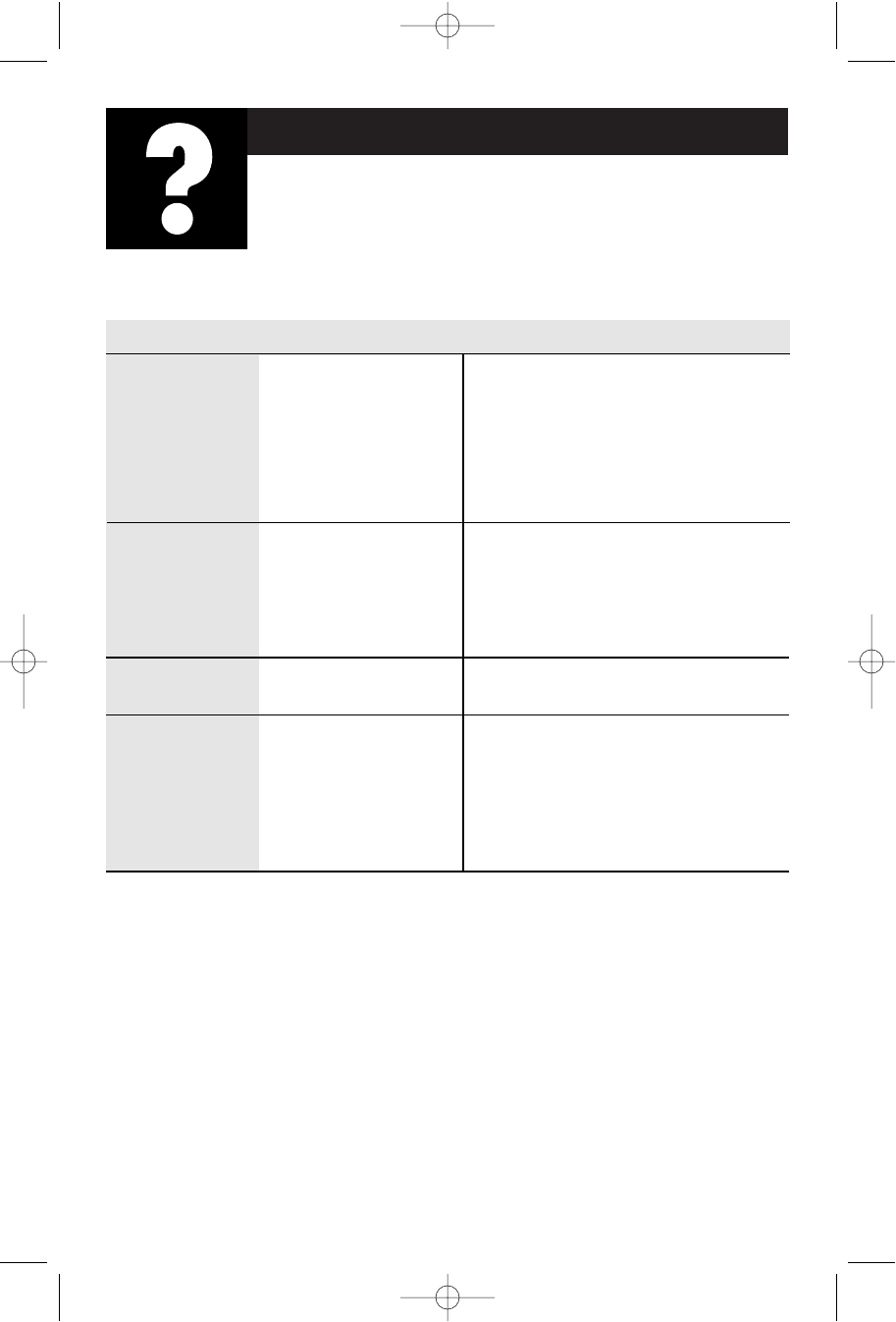
36
If Something Goes Wrong
Before You Call For Service
Oven will not
start
Floor of the oven is
warm, even when
the oven has not
been used
“LOC” appears
on display
Vent fan will not
turn off
Problem Possible Cause What to Do
A fuse in your home •Replace fuse or reset circuit breaker.
may be blown or the
circuit breaker tripped.
Power surge. •Unplug the microwave oven, then plug
it back in.
Plug not fully inserted •Make sure the 3-prong plug on the
into wall outlet. oven is fully inserted into wall outlet.
The cooktop light is •This is normal.
located below the oven
floor. When the light
is on, the heat it
produces may make the
oven floor get warm.
The control has been •Press and hold CLEAR/OFF for
locked. about 3 seconds to unlock the control.
The vent fan •The vent fan cannot be turned off
automatically turns on while the microwave is operating.
to cool internal parts This is normal. Wait for the microwave
while the microwave to turn off and the fan will either go
is on. off automatically or you will need to
turn it off by pressing the Vent Fan
pad after the microwave is off.
39-40427v06 6/1/04 4:16 PM Page 36

37
•Steam or vapor escaping
from around the door.
•Light reflection around
door or outer case.
•Dimming oven light and
change in the blower
sound at power levels
other than high.
•Dull thumping sound
while oven is operating.
•The vent fan operating
while the microwave is
operating. The vent fan
will not go off nor can it
be turned off until the
microwave is off.
•TV-radio interference
might be noticed while
using the microwave.
Similar to the interference
caused by other small
appliances, it does not
indicate a problem with
the microwave. Plug the
microwave into a different
electrical circuit, move the
radio or TV as far away
from the microwave as
possible or check the
position and signal of
the TV/radio antenna.
Things That
Are Normal
39-40427v06 6/1/04 4:16 PM Page 37

38
Hotpoint.com Have a question or need
assistance with your
appliance? Try the
Hotpoint Website 24 hours
a day, any day of the year!
You can also shop for
more great Hotpoint
products and take
advantage of all of our
on-line support services
designed for your
convenience.
Hotpoint Website
Hotpoint.com
800.GE.CARES
(800.432.2737)
Expert Hotpoint repair
service is only one step
away from your door.
Get on-line and schedule
your service at your
convenience 24 hours
any day of the year!
Or call 800.GE.CARES
(800.432.2737) during
normal business hours.
Schedule Service
GEAppliances.com
800.TDD.GEAC
(800.833.4322)
GE supports the Universal
Design concept—products,
services and environments
that can be used by people
of all ages, sizes and
capabilities. We recognize
the need to design for a
wide range of physical and
mental abilities and
impairments. For details
of GE’s Universal Design
applications, including
kitchen design ideas for
people with disabilities,
check out our Website
today. For the hearing
impaired, please call
800.TDD.GEAC
(800.833.4322).
Real Life
Design Studio
www.GEAppliances.com
800.626.2224
Purchase a Hotpoint
extended warranty and
learn about special
discounts that are available
while your warranty is still
in effect. You can purchase
it on-line anytime, or call
800.626.2224 during
normal business hours.
Hotpoint Consumer Home
Services will still be there
after your warranty expires.
Extended Warranties
Hotpoint Service Numbers
We’ll Be There!
39-40427v06 6/1/04 4:16 PM Page 38

39
Hotpoint.com
800.626.2002
Individuals qualified
to service their own
appliances can have
parts or accessories sent
directly to their home.
(VISA, MasterCard and
Discover cards are
accepted.) Order on-line
today, 24 hours every day or
by phone at 800.626.2002
during normal business
hours.
Instructions contained
in this manual cover
procedures to be
performed by any user.
Other servicing generally
should be referred
to qualified service
personnel. Caution
must be exercised, since
improper servicing may
cause unsafe operation.
Parts and
Accessories
Register Your
Appliance
Hotpoint.com
Register your new
appliance on-line—
at your convenience!
Timely product registration
will allow for enhanced
communication and
prompt service under the
terms of your warranty,
should the need arise.
You may also mail in the
pre-printed registration
card included in the
packing material.
39-40427v06 6/1/04 4:16 PM Page 39

FULL ONE-YEAR WARRANTY
For one year from date of original
purchase, we will provide, free of charge,
parts and service labor in your home to
repair or replace any part of the microwave
oven that fails because of a manufacturing
defect.
LIMITED ADDITIONAL
FOUR-YEAR WARRANTY
For the second through the fifth year
from the date of original purchase, we
will provide, free of charge, a replacement
magnetron tube if the magnetron tube
fails because of a manufacturing defect.
You pay for the service trip to your home
and service labor charges.
************************************
This warranty is extended to the original
purchaser and any succeeding owner for
products purchased for ordinary home use
in the 48 mainland states, Hawaii and
Washington, D.C. In Alaska the warranty
is the same except that it is LIMITED
because you must pay to ship the product
to the service shop or for the service
technician’s travel costs to your home.
All warranty service will be provided by
our Factory Service Centers or by our
authorized Customer Care®servicers
during normal working hours.
Should your appliance need service,
during warranty period or beyond, call
800.GE.CARES (800.432.2737).
MICROWAVE OVEN
WARRANTY
What Is Covered
What Is Not Covered
Staple sales slip or cancelled check here. Proof of original
purchase date is needed to obtain service under warranty.
•Service trips to your home to teach you
how to use the product.
•
Improper installation, delivery or
maintenance.
If you have an installation problem, contact
your dealer or installer. You are responsible
for providing adequate electrical,
exhausting and other connecting facilities.
•Replacement of house fuses or resetting
of circuit breakers.
•Replacement of the cooktop light bulbs.
•Failure of the product if it is misused, or
used for other than the intended purpose
or used commercially.
•Damage to product caused by accident,
fire, floods or acts of God.
•Incidental or consequential damage
caused by possible defects with this
appliance.
•Damage caused after delivery.
Some states do not allow the exclusion or limitation of incidental or consequential damages,
so the above limitation or exclusion may not apply to you. This warranty gives you specific
legal rights, and you may also have other rights which vary from state to state. To know what
your legal rights are in your state, consult your local or state consumer affairs office or your
state’s Attorney General.
Warrantor: General Electric Company. Louisville, KY 4022
5
Printed in Korea
39-40427v06 6/1/04 4:16 PM Page 40